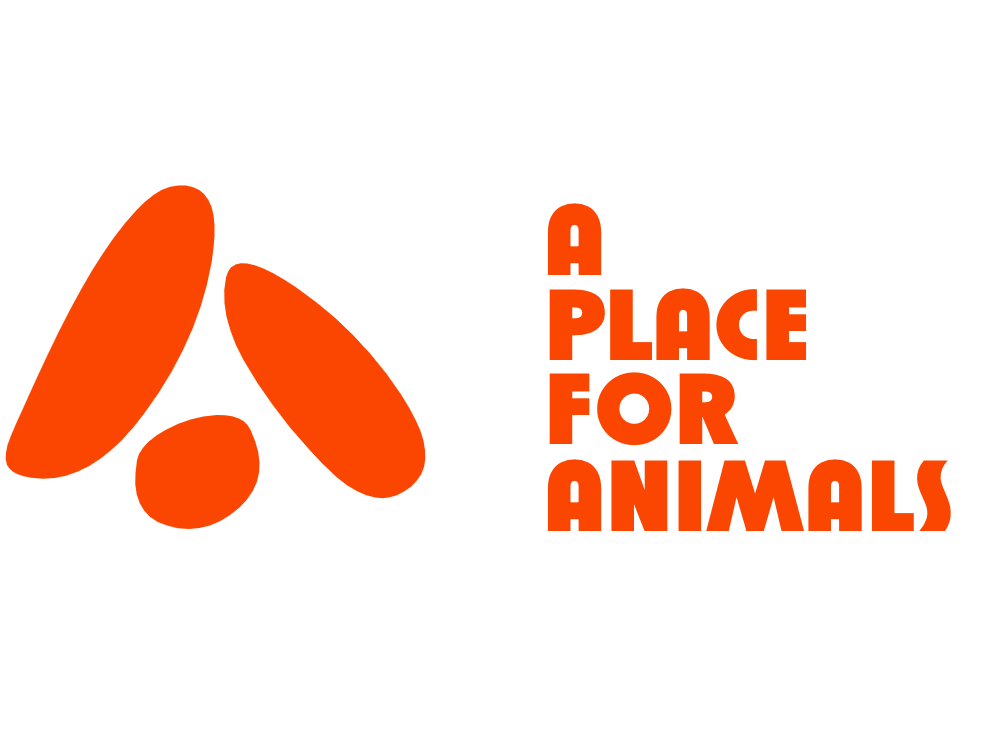Deers
Effective Deer Repellent Solutions for Gardens
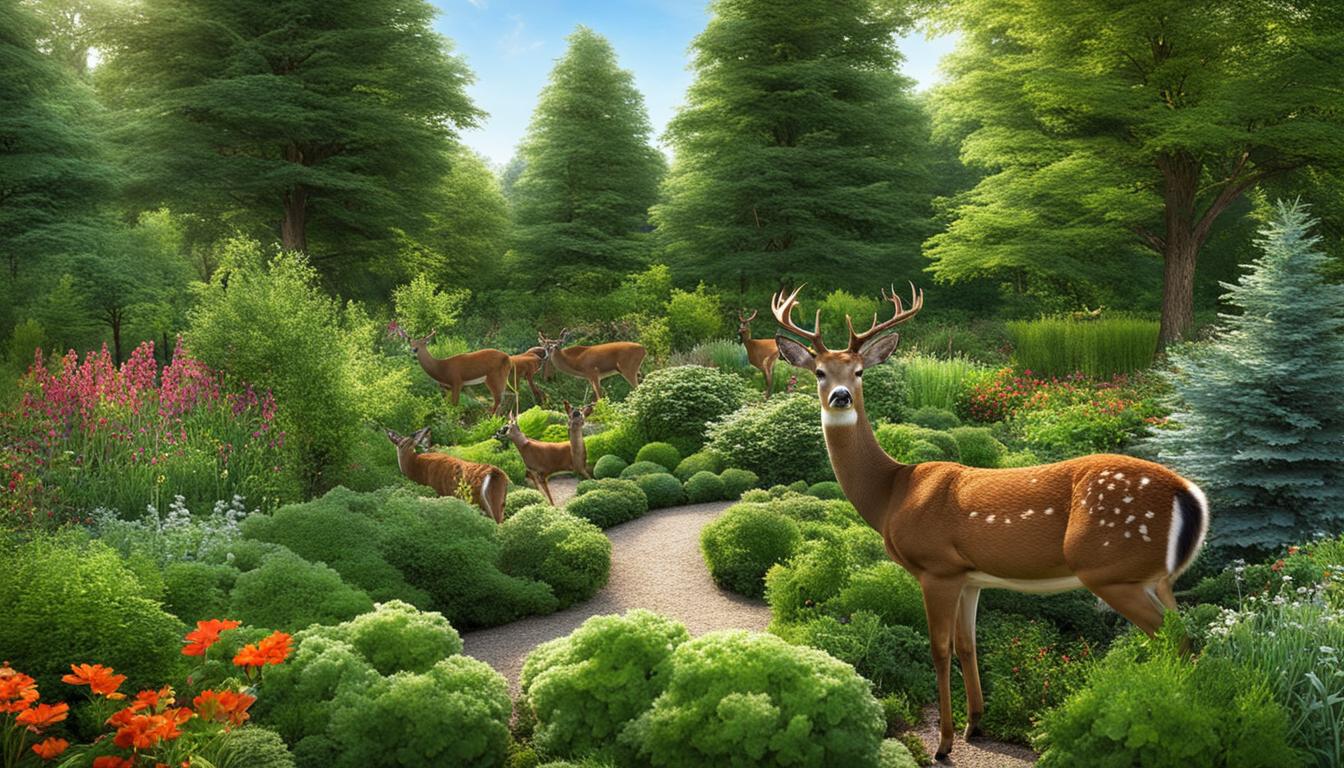
Did you know that deer can cause extensive damage to gardens, destroying trees, shrubs, and vegetable patches? Not only that, but they can also bring ticks, spreading Lyme disease. Protecting your garden from these graceful yet destructive creatures is crucial to ensure the health and beauty of your plants.
In this article, we will explore various effective deer repellent strategies that will help keep these herbivores at bay, safeguarding your garden from their potential harm. From physical barriers and scare tactics to natural repellents and landscaping techniques, we will cover a range of methods to help you find the solution that works best for your specific situation.
Key Takeaways:
- Deer can cause significant damage to gardens and carry ticks that spread Lyme disease.
- Implementing effective deer repellent strategies is crucial to protect your plants and maintain a healthy garden.
- Methods include physical barriers, scare tactics, natural repellents, and strategic landscaping techniques.
- Experimentation and regular maintenance are key to finding the most successful deer repellent solutions.
- Selecting deer-resistant plants and incorporating DIY natural repellents can also contribute to garden protection.
How to Protect Your Trees and Plants from Deer
Deer can cause significant damage to your garden, destroying trees, shrubs, and plants. To safeguard your landscape, it’s essential to employ various strategies that discourage deer from entering your yard. By combining different methods, such as eliminating attractants, creating barriers, and implementing deterrents, you can effectively protect your trees and plants from deer garden damage.
Eliminate Deer Attractants
To discourage deer from entering your yard, it’s crucial to remove any tempting attractions. Harvest produce as soon as it ripens, preventing deer from feasting on your crops. Additionally, keep fallen fruits, nuts, and other edible vegetation cleaned up, eliminating food sources that may entice deer into your garden.
Create a Barrier with Deer-Resistant Plants
Planting deer-resistant vegetation closer to your home can act as a natural barrier, deterring deer from venturing further into your yard. Opt for plants that deer typically avoid, such as daffodils, lavender, and yarrow. These species have strong scents or textures that deer find unappealing, making them excellent choices for protecting your trees and plants.
Maintain Your Landscape to Deter Deer
To make your garden less inviting to deer, it’s important to maintain your landscape effectively. Trim densely planted areas, removing excess foliage that may provide cover for deer. Decluttering your yard and ensuring optimal visibility can discourage these animals from entering. Additionally, consider using motion-activated sprinklers to startle deer and keep them away from your trees and plants.
“By combining different methods, such as eliminating attractants, creating barriers, and implementing deterrents, you can effectively protect your trees and plants from deer garden damage.”
Tree and Plant Protection Methods
| Method | Description |
|---|---|
| Eliminating Attractants | Harvesting produce promptly and removing fallen fruits and nuts to eliminate food sources for deer. |
| Planting Deer-Resistant Plants | Choosing species that are unappealing to deer as a natural barrier. |
| Maintaining Landscape | Trimming dense foliage and using motion-activated sprinklers to deter deer. |
Implementing these strategies will help protect your trees and plants from deer garden damage. By eliminating attractants, creating barriers, and maintaining your landscape, you can create an environment that is less enticing to deer. Stay vigilant and adjust your tactics as needed to keep these garden pests at bay.
Ideas for Deterring Deer from Your Yard
When it comes to keeping deer out of your yard, there are various ideas you can implement. By utilizing effective deer deterrents, you can prevent deer damage and maintain a thriving landscape. Consider the following strategies:
Create Levels in Your Yard
One way to deter deer from entering your yard is by creating levels. Sunken beds or terraces can make it challenging for deer to navigate and discourage them from venturing further into your property.
Utilize Your Dog’s Presence
Deer are naturally wary of dogs, making them an excellent deterrent. Allowing your dog to spend time in the yard can help keep deer at bay. The scent and presence of a dog may make deer think twice about entering your yard.
Choose Deer-Unfriendly Plants
Another effective approach is to incorporate plants with strong aromas or textures that deer find unappealing. Consider adding lavender, a plant known for its fragrant aroma, or lamb’s ear, which has soft and fuzzy leaves. These types of plants can make your landscape less inviting to deer.
The scent and presence of a dog in your yard can help deter deer from entering.
By implementing these ideas, you can effectively deter deer from entering your yard and prevent damage to your plants. Creating levels, utilizing your dog’s presence, and selecting deer-unfriendly plants are all strategies that can help keep your yard deer-free.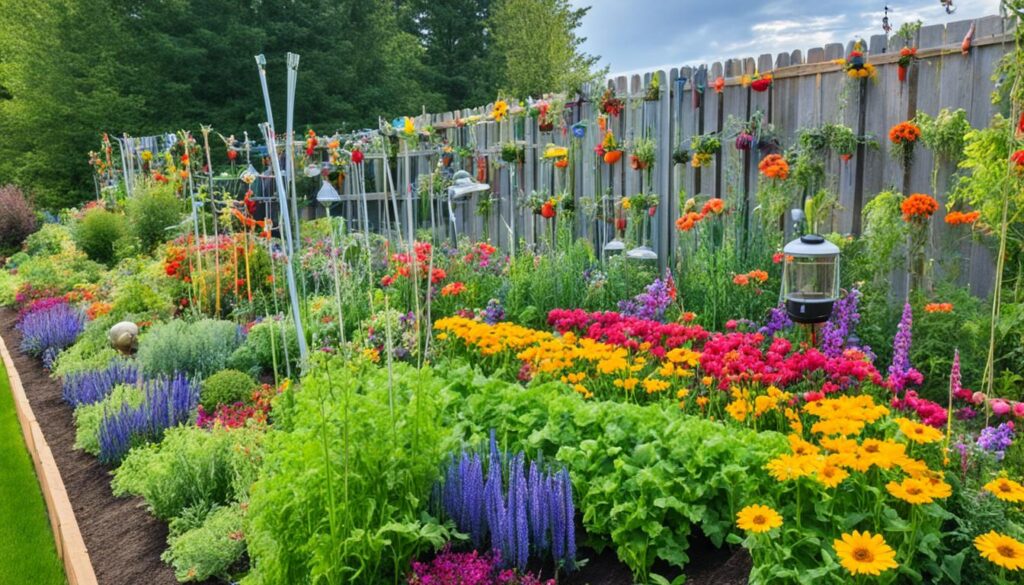
Stay tuned for the next section, where we will explore the use of physical barriers to keep deer out of your garden.
Using Physical Barriers to Keep Deer Out
When it comes to protecting your garden from deer, physical barriers can be highly effective. By installing a tall fence or utilizing natural hedges, you can create a formidable obstacle that deters deer from entering your yard. Additionally, tree netting or wraps provide targeted protection for individual plants.
The Power of Deer Fences
Deer fences are a popular choice for keeping these unwanted visitors out of your garden. A sturdy fence acts as a physical deterrent, preventing deer from accessing your plants. To ensure its effectiveness, it’s important to make sure the fence is:
- At least eight feet tall: This height is crucial as deer have the ability to jump impressive heights when motivated by food or threats.
- Without any gaps wider than six inches: Even the smallest gap can be an invitation for deer to slip through, so maintaining a tight barrier is essential.
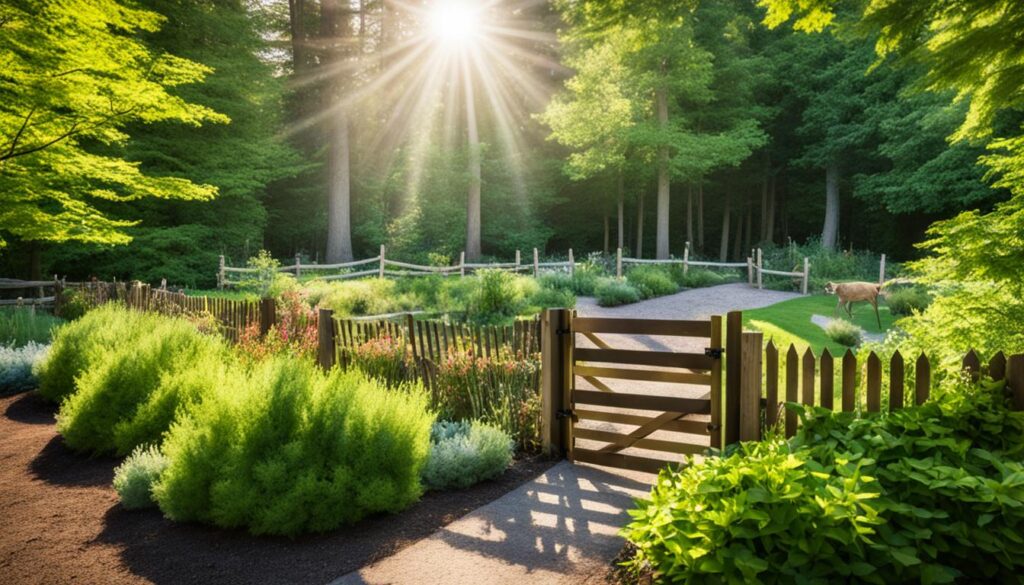
Hedges as Natural Barriers
In addition to fences, utilizing hedges strategically can help keep deer away from your garden. Certain types of dense, thorny shrubs such as juniper, holly, or barberry can act as natural deterrents. Planting these hedges strategically along the perimeter of your garden can create an extra layer of defense against deer intrusion.
Tree Netting and Wraps for Targeted Protection
While fences and hedges offer broad protection, tree netting and wraps provide targeted defense for individual plants that are particularly vulnerable to deer damage. Tree netting is an effective means of safeguarding small to medium-sized trees by creating a physical barrier that prevents deer from reaching the foliage and branches.
To protect young trees from feeding and rubbing damage, tree wraps serve as an effective deterrent. Wrapping the lower trunk with a protective material, such as burlap or tree wrap, creates a physical barrier that discourages deer and prevents harm to the tree bark.
Incorporating a combination of these physical deer deterrents—deer fences, hedges, tree netting, and wraps—can significantly reduce the risk of deer damage in your garden, ensuring that your plants thrive undisturbed by these hungry visitors.
Scare Tactics to Keep Deer Away
When it comes to protecting your garden from deer, scare tactics can be an effective solution. Startling the deer and making them feel unwelcome can discourage them from entering your yard. Here are some scare tactics that can help keep deer away:
Motion-Activated Sprinklers
Motion-activated sprinklers are a popular choice for deterring deer. These devices use infrared sensors to detect movement and then release a blast of water combined with a loud noise. This sudden burst of water and sound startles the deer, making them think twice about returning to your garden. Motion-activated sprinklers are safe and environmentally friendly, providing an effective way to keep deer at bay.
Ultrasonic Devices
Another effective method for scaring off deer is to use ultrasonic devices. These devices emit high-frequency noise that deer find unpleasant and irritating. The ultrasonic sound is inaudible to humans, so you won’t be bothered by it. Simply place these devices strategically around your garden, and the unpleasant noise will act as a deterrent, keeping deer away.
Presence of a Dog
Deer are naturally wary of dogs, seeing them as potential predators. If you have a dog, allow them to spend time in the yard. The presence and scent of a dog can deter deer from entering your property. Even if you don’t own a dog, consider getting a motion-activated device that emits the sound of a barking dog. This can give the impression that a dog is present, effectively scaring deer away.
“Busy” Décor
Adding “busy” décor to your yard can create a visually distracting environment for deer. Hang wind chimes or place moving decorations in your garden. The constant movement and noise can startle deer and make them uncomfortable, deterring them from approaching your plants. Another option is to use reflective tape or shiny objects to create flashes of light, which can further disorient and repel deer.
By incorporating these scare tactics into your garden protection strategy, you can effectively keep deer away from your plants and preserve your beautiful landscape.
Using Deer Repellents
Deer repellents are a valuable tool in protecting your garden from the relentless grazing of these curious creatures. By obstructing a deer’s sense of smell and taste, repellents make your plants less appealing to these hungry visitors.
An effective option for deer repellent is the Deer Off® products. These products emit a scent that reminds deer of a decaying animal and taste like garlic, which deer find unappealing. By utilizing Deer Off® repellents, you can create a barrier that deters deer from destroying your garden.
If you prefer a more DIY approach, homemade repellents can also be effective in deterring deer. By combining ingredients such as soap, eggs, vinegar, and essential oils, you can create your own natural deer repellent. These DIY solutions offer an economical and eco-friendly alternative to store-bought sprays.
| Deer Repellent Ingredients | Instructions |
|---|---|
| Soap | Mix grated soap with water and spray on plants. |
| Eggs | Beat eggs with water and spray on plants. |
| Vinegar | Mix vinegar with water and spray on plants. |
| Essential Oils | Combine essential oils with water and spray on plants. |
Benefits of Deer Repellents
Using deer repellents comes with several benefits:
- Protects your plants: Deer repellents create a protective barrier that discourages deer from feasting on your prized plants.
- Cost-effective: Homemade deer repellents can be made from common household ingredients, saving you money on expensive store-bought options.
- Environmentally-friendly: Natural deer repellents are less toxic than chemical-based alternatives, making them a safer choice for your garden and the environment.
- Easy to apply: Whether using store-bought or homemade repellents, applying these solutions to your plants is a simple process that requires minimal effort.
By using natural deer repellents such as Deer Off® products or DIY sprays, you can effectively protect your garden from deer damage and maintain the beauty of your landscape.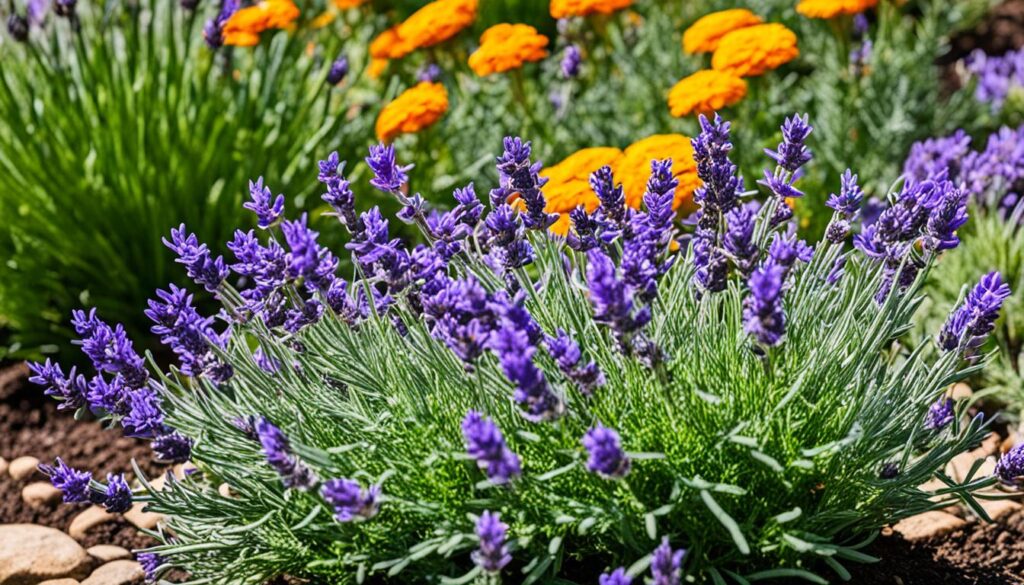
How Often to Use and Apply Deer Repellents
When it comes to protecting your garden from deer, applying repellents at the right frequency is crucial. Several factors, including the time of year, rainfall, and the level of feeding pressure from deer, can influence how often you need to reapply deer repellents.
The frequency of applying deer repellents depends on factors such as the time of year, rainfall, and the level of feeding pressure from deer.
If you’re using homemade egg-based repellents, they typically last around two weeks before they need to be reapplied. On the other hand, essential oil-based repellents can last up to five weeks without rainfall.
It’s important to keep in mind that repellent effectiveness can vary depending on weather conditions and deer activity in your area. It’s essential to monitor your garden regularly and reapply repellents after rain or when the scent has dissipated.
Reapplication Tips:
- Check the weather forecast: If rain is expected, reapply the repellents beforehand to ensure their effectiveness is not compromised.
- Monitor deer activity: If you notice increased deer activity and signs of feeding, consider reapplying the repellents as a preventative measure.
- Follow product instructions: Different repellent products may have specific guidelines for reapplication. Always refer to the instructions provided by the manufacturer.
By applying deer repellents at the right frequency, you can maintain long-lasting protection for your garden and effectively deter deer from causing damage to your plants.
| Repellent Type | Lasting Duration |
|---|---|
| Egg-based repellents | Around two weeks |
| Essential oil-based repellents | Up to five weeks without rainfall |
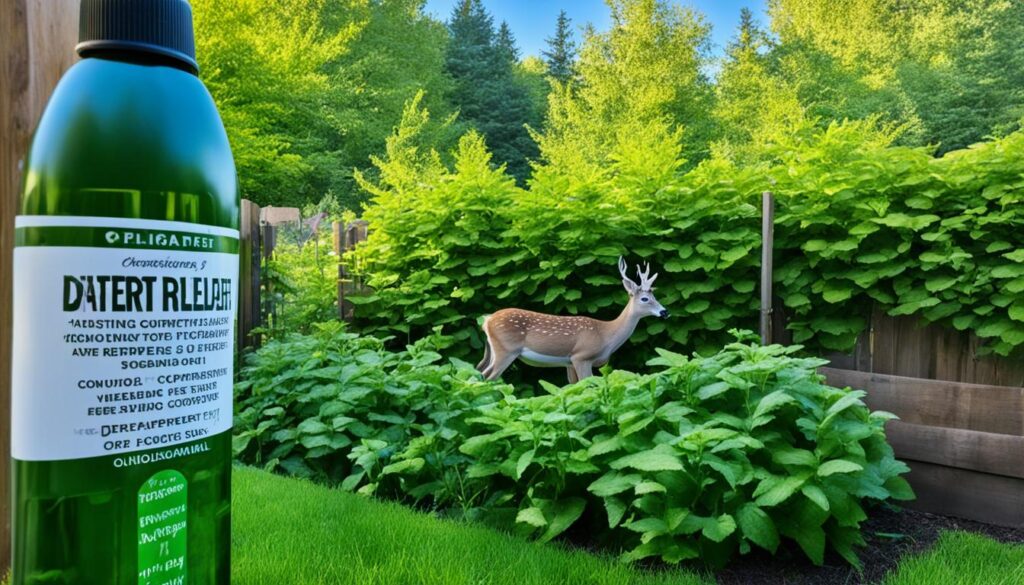
Tips for Maintaining Your Landscape to Deter Deer
Maintaining your landscape is essential in preventing deer from causing damage to your garden. By following these tips, you can create a deer-resistant gardening environment and keep your plants safe.
Keep Your Yard Uninviting
Deer are attracted to areas that provide cover, such as dense shrubs or overgrown vegetation. Trim these areas regularly, ensuring that there are no hiding spots for deer to take advantage of. By removing potential cover, you make your yard less appealing to deer and reduce the risk of them infiltrating your garden.
Harvest Crops Early
Deer are particularly attracted to gardens with mature crops. To prevent them from feasting on your fruits and vegetables, harvest them as soon as they’re ready. This not only helps to protect your harvest but also minimizes the scent of ripe produce, which can entice deer to enter your yard.
Remove Cover to Discourage Deer
Deer prefer areas with quick escape routes in case of predators. By eliminating potential cover, such as tall grass or low-hanging branches, you discourage deer from staying in your yard. Regularly monitor your landscape and remove any vegetation that could provide a hiding spot for deer.
Monitor and Adjust Deterrent Strategies
Regularly evaluate the effectiveness of your deterrent strategies and make adjustments as needed. Deer are intelligent creatures that can adapt to their surroundings. By changing tactics, such as relocating scare devices or updating your deer repellents, you can maximize their effectiveness in deterring deer from your garden.
Recommended Practices for Deer-Resistant Gardening
| Practice | Effectiveness |
|---|---|
| Regular trimming of vegetation | High |
| Early harvest of crops | High |
| Removal of potential cover | High |
| Monitoring and adjustment of deterrents | Medium to High |

Maintaining your landscape plays a crucial role in preventing deer attraction to your garden. By incorporating these tips and regularly tending to your yard, you can create a deer-resistant environment and protect your plants from potential damage.
Top Deer-Resistant Plants for Your Garden
When it comes to protecting your garden from deer, choosing the right plants can make a significant difference. Certain plants have properties that make them unappealing to deer, helping to deter these hungry creatures from wreaking havoc in your garden. Here are some top deer-resistant plants to consider:
Lavender
Lavender is not only beloved for its fragrant blooms and beautiful purple hue but is also a standout choice for deterring deer. The strong aroma that lavender emits is highly disliked by deer, making it an excellent addition to your garden.
Rosemary
Rosemary is not just a versatile herb for cooking; it’s also a plant that deer tend to avoid. The pungent scent and tough foliage of rosemary make it an unpalatable choice for deer, keeping them at bay from your garden beds.
Garlic
A staple ingredient in many culinary dishes, garlic is also a popular choice for gardeners looking to keep deer at bay. The strong smell of garlic is unappealing to deer, making it an effective deterrent plant for your garden.
Lamb’s Ear
Lamb’s ear is a perennial with soft, fuzzy foliage that deer find unattractive. The texture and appearance of the leaves make it less appealing for deer to graze on, making it an excellent choice for deer-resistant gardens.
Globe Thistle
Globe thistle is known for its spiky, thorny appearance, which serves as a natural defense against deer. The prickly foliage makes it uninviting for deer to nibble on, making it an ideal addition to your deer-resistant garden.
A valuable symbol that no HTML tag should be applied anymore, just a simple, beautiful table.
| Plant | Reason for Deer Resistance |
|---|---|
| Lavender | Strong aroma disliked by deer |
| Rosemary | Pungent scent and tough foliage |
| Garlic | Strong smell unappealing to deer |
| Lamb’s Ear | Fuzzy foliage texture |
| Globe Thistle | Prickly foliage deters deer |
By incorporating these deer-resistant plants into your garden, you can create a natural deterrent that helps protect your plants from unwanted grazing. Remember to plant them closer to your home and in areas that are more vulnerable to deer attacks. These plants not only add beauty to your garden but also ensure that deer are less likely to feast on your beloved plant choices.
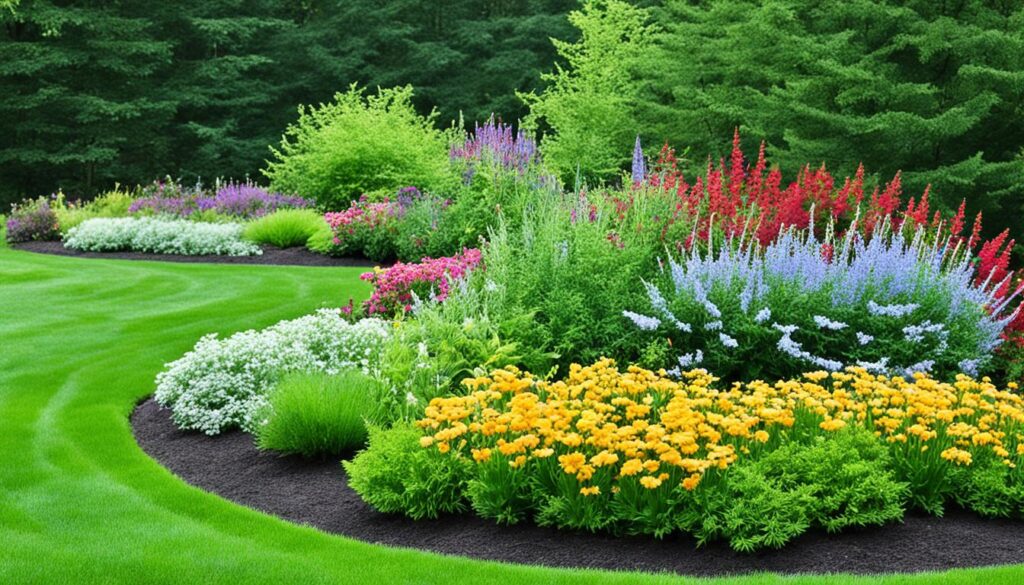
DIY Natural Deer Repellent Recipes
If you’re looking for a natural and effective way to keep deer away from your garden, why not try making your own homemade deer repellent? By using common household ingredients, you can create DIY deer sprays that are not only cost-effective but also less toxic for your garden’s soil. Here are two simple recipes to get you started:
1. Homemade Deer Spray with Soap and Pungent Substances
This homemade deer spray utilizes the strong smell of soap and pungent substances to deter deer from approaching your plants.
- Grate a bar of strong-scented soap, such as Irish Spring or Ivory soap.
- Combine the grated soap with pungent substances like rotten eggs or spoiled milk.
- Add water and mix well to create a liquid solution.
- Pour the mixture into a spray bottle.
- Spray the solution on and around your plants, focusing on areas where deer activity is high.
This homemade deer spray works by overwhelming the deer’s sense of smell and making your plants less appealing to them.
2. DIY Deer Repellent Spray with Vinegar and Essential Oils
This DIY deer repellent spray combines the strong scent of vinegar with the repellent properties of essential oils.
- Mix equal parts vinegar and water in a spray bottle.
- Add a few drops of essential oils with strong aromas that deer dislike, such as peppermint, clove, or cinnamon oil.
- Shake the bottle well to blend the ingredients.
- Spray the solution on your plants, focusing on areas that are vulnerable to deer damage.
The combination of vinegar and essential oils in this DIY deer repellent spray helps mask the smell of your plants and creates an unpleasant environment for deer.
By using these homemade deer repellent recipes, you can take a natural approach to protecting your garden from deer damage. These DIY solutions offer a cost-effective alternative to store-bought sprays while being gentle on your garden’s soil.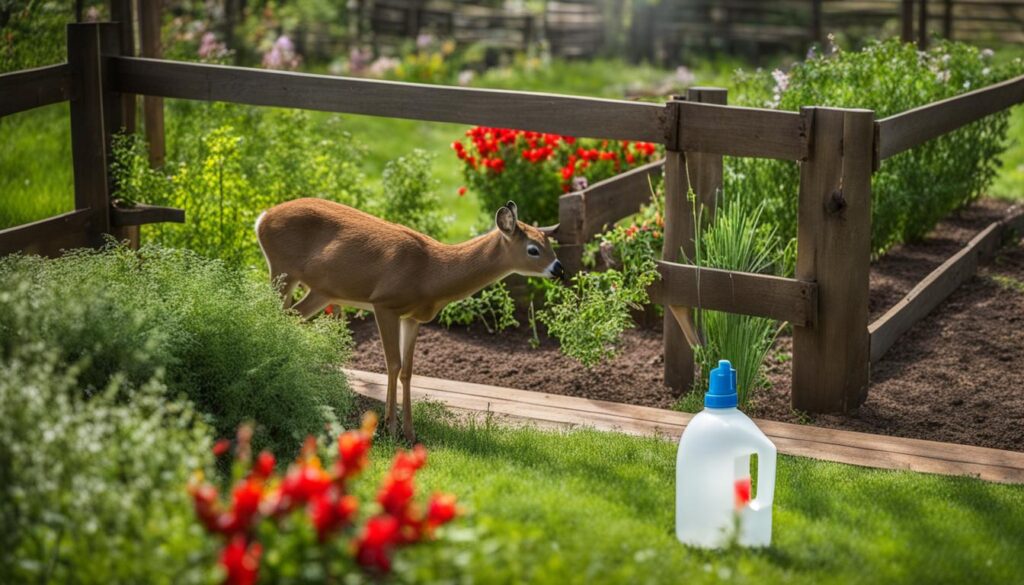
Conclusion
Protecting your garden from deer is essential to ensure the safety and health of your plants. By utilizing a combination of strategies, including eliminating attractants, implementing physical barriers, using scare tactics, and applying effective deer repellents, you can successfully deter deer from invading your garden.
Start by identifying and removing potential deer attractants, such as ripe produce, to minimize the appeal of your garden. Utilize physical barriers like tall fences without gaps wider than six inches or natural hedges to create a deterrent. Incorporating scare tactics such as motion-activated sprinklers, ultrasonic devices, and the presence of a dog in your yard can further discourage deer.
Investing in effective deer repellents like Deer Off® products, which emit a scent reminding deer of decaying animals and taste unappealing to them, is another powerful safeguard for your garden. You can also opt for natural homemade repellents using household ingredients such as soap, rotten eggs, vinegar, and essential oils.
Remember, experimenting with different strategies and adjusting them as needed will help you find the most successful deer deterrent solutions for your garden. By combining these methods and maintaining your landscape, you can enjoy a thriving garden free from the destructive effects of deer.FAQ
What are some effective deer repellent solutions for gardens?
How can I protect my trees and plants from deer?
What are some ideas to deter deer from entering my yard?
How can I use physical barriers to keep deer out?
What scare tactics can I use to keep deer away?
What can I use as deer repellents?
How often should I apply deer repellents?
What tips can help me maintain my landscape to deter deer?
What are some top deer-resistant plants for my garden?
How can I make DIY natural deer repellent recipes?
How can I effectively protect my garden from deer?
Paul’s love for animals knows no bounds. As a dedicated writer and animal lover, Paul brings a unique perspective to our team. His firsthand experiences with various animals enrich our content and provide valuable insights into their behavior and needs. Whether he’s sharing tips for pet care or shedding light on pressing conservation issues, Paul’s passion for animals shines through in everything he does.
Deers
Understanding the Unique Muntjac Deer Face
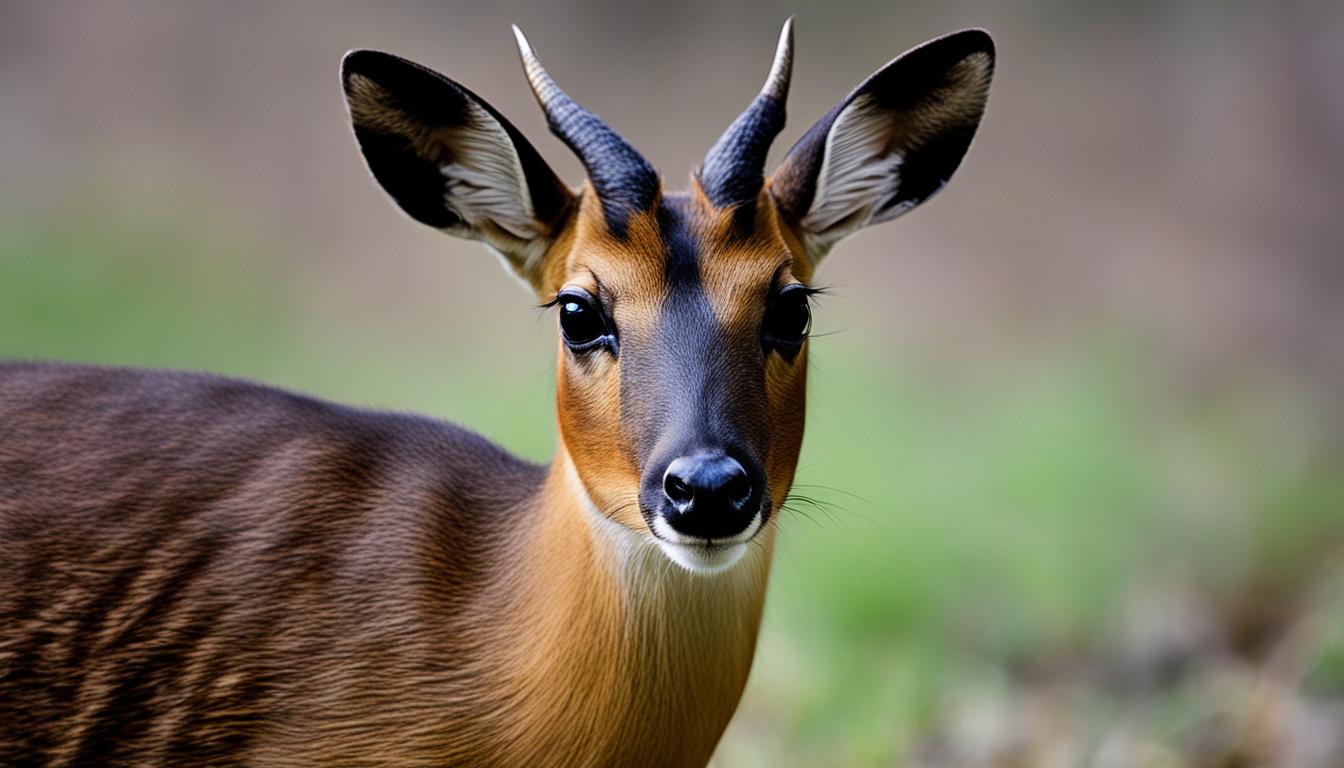
Did you know that the muntjac deer is a small species of deer that is often overlooked due to its size? These fascinating creatures, weighing between 9 to 18kg, are known for their unique facial features that set them apart from other deer species.
Unlike larger deer species, the muntjac deer has distinctive facial glands, including frontal glands and pre-orbital glands. These glands play a crucial role in their communication and scent marking behaviors. The muntjac deer uses these glands to convey important information about their sex, age, reproductive status, and social hierarchy.
If you’re curious to learn more about the muntjac deer and its fascinating features, read on!
Key Takeaways:
- The muntjac deer is a small deer species that often goes unnoticed due to its size.
- They have unique facial features, including frontal glands and pre-orbital glands.
- These facial glands play a significant role in their communication and scent marking behaviors.
- Understanding the muntjac deer’s unique features can provide insights into their behavior and habitat.
- Conservation efforts focus on managing the impact of muntjac deer on ecosystems and native species.
Muntjac Deer Behavior and Breeding
Muntjac deer exhibit interesting behavior patterns and breeding habits that contribute to their success in the UK. These small deer species engage in year-round breeding, with little variation in their behavior throughout the seasons. Their courtship rituals and scent marking techniques play a crucial role in the mating process.
One notable aspect of muntjac deer behavior is their vocalization. They are extremely vocal animals, relying on barks to communicate with each other. This vocalization serves various purposes, including establishing territorial boundaries and attracting mates.
The scent marking behavior of muntjac deer is particularly fascinating. Males tend to scent-mark more frequently than females, using urine and gland secretions to mark their territory. This scent marking not only helps them establish dominance but also serves as a signal to potential mates.
Muntjac deer also possess unique adaptations that are essential for their breeding success. One such adaptation is the presence of elongated canines, commonly referred to as “fangs.” These canines are used for close-up combat during territorial disputes and can be folded back when not in use.
During the breeding season, female muntjacs often call out after giving birth to attract potential mates. This behavior ensures that they can mate shortly after giving birth, consequently maximizing their reproductive potential. It is not uncommon for female muntjacs to spend a significant portion of their lives pregnant.
In conclusion, the behavior and breeding patterns of muntjac deer are fascinating and unique. Their year-round breeding, courtship rituals, scent marking, and unique adaptations contribute to their ability to thrive in the UK. Understanding these behaviors allows us to appreciate the complexity of these small, yet resilient, creatures.
The Spread and Impact of Muntjac Deer in the UK
Muntjac deer, although not native to the UK, were introduced around the turn of the 20th century. Since then, these non-native species have rapidly expanded their presence across England and Wales, making them a familiar sight in both rural and suburban areas. However, their growing population has raised concerns due to the ecological impact they have on their surroundings.
Being an invasive species, muntjac deer have disrupted the natural balance of ecosystems in the UK. One notable ecological consequence of their presence is the impact on woodland wildflowers. Muntjacs have a voracious appetite and can significantly affect the growth and survival of woodland wildflowers, such as the beloved bluebells and primroses. Their browsing behavior often limits the low growth of these delicate flowers, affecting the overall biodiversity of woodlands.
Furthermore, the spread of muntjac deer poses a threat to the habitat of other wildlife species, such as the nightingale. These deer can degrade the nesting grounds and foraging areas of nightingales, potentially leading to a decline in their population. Their adaptability and ability to thrive in various environments have made muntjacs a concern for gardeners and conservationists alike.
To address these ecological concerns, it is essential to implement effective management strategies to control the muntjac deer population and mitigate their impact on woodland ecosystems. By understanding their behavior and habitat requirements, conservation efforts can be tailored to minimize the disruption caused by these non-native deer species.
The following table summarizes the key points regarding the spread and impact of muntjac deer in the UK:
| Key Points |
|---|
| Muntjac deer were introduced to the UK around the turn of the 20th century |
| They have since spread across England and Wales |
| Muntjac deer are considered an invasive, non-native species |
| They have a negative impact on woodland wildflowers |
| Woodland biodiversity is affected by muntjacs’ browsing habits |
| There are concerns about the degradation of nightingale habitat |
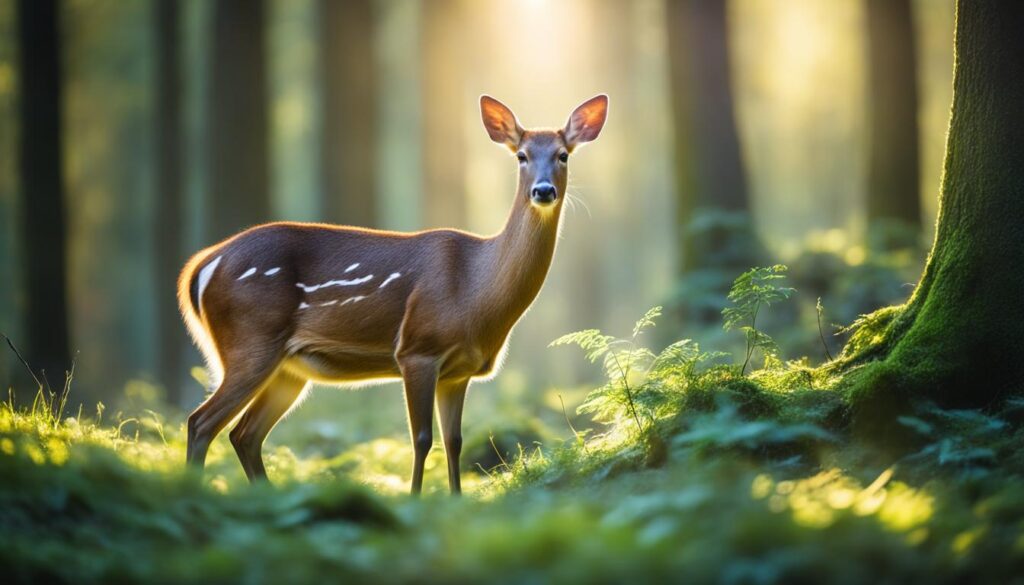
The Distinctive Facial Features of the Muntjac Deer
One of the most distinctive features of the muntjac deer is their facial glands. They have two sets of scent glands on their face. The first set is the preorbital glands located just in front of the eyes, and the second set is the frontal glands on the forehead. These glands play a crucial role in the muntjac deer’s communication and bonding with other deer in the forest.
The preorbital glands, situated just in front of the eyes, expand and secrete a personalized concoction of chemical compounds. The mixture conveys vital information about the deer, such as its sex, age, reproductive status, overall health, well-being, and social hierarchy within the herd. By rubbing their face against objects, the muntjac deer can spread their scent and let others know they are present.
The frontal glands, located on the forehead, also secrete scent-marking compounds, contributing to the muntjac deer’s communication strategy. These compounds help establish territories, attract mates, and establish dominance within the herd. The muntjac deer utilize their unique facial features and scent glands to navigate their social interactions and maintain a harmonious balance within their forest habitat.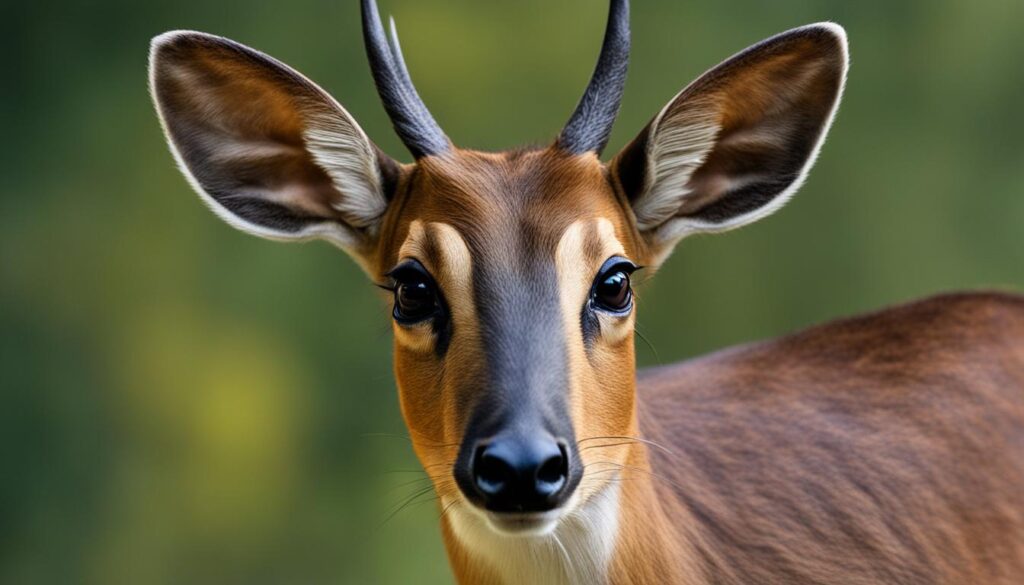
“The preorbital and frontal glands of the muntjac deer serve as their toolkit for communication and bonding with other deer. Through their personalized scent signals, they can convey crucial information and establish their place within the social hierarchy.”
– Wildlife Expert
The Infamous Barking Sound of the Muntjac Deer
Muntjac deer are known as “barking deer” due to their loud and distinctive barks. They can emit a gruff shout and stamp their front feet as a territorial call. Males may bark to attract females or ward off predators. Their barking sound can be mistaken for a human scream or a fox. Muntjac deer can be very vocal despite their small size, and their barking can last for many hours. This unique vocalization is a notable characteristic of the muntjac deer and contributes to their reputation as a unique and interesting species.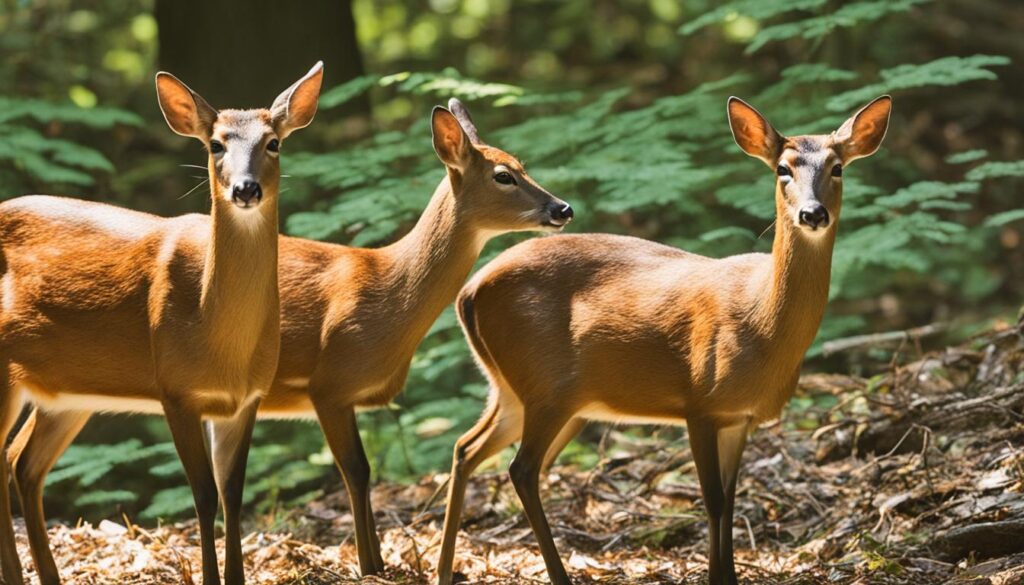
| Vocalization | Meaning |
|---|---|
| Barking sound | Territorial call, attracting mates, or warding off predators |
| Gruff shout | Expression of dominance or in response to a perceived threat |
| Stamping front feet | Enhancing the territorial display and attracting attention |
The muntjac deer’s vocalizations are not only a means of communication but also a way to establish and maintain their territory. By emitting their unique barking sound, they are able to deter potential competitors and attract potential mates. These vocalizations can be heard throughout their habitat, adding to the ambiance of the woodland environment. It is truly fascinating how such small deer can produce such loud and distinct vocalizations.
The Adaptability and Diet of Muntjac Deer
Muntjac deer are highly adaptable creatures, capable of thriving in a diverse range of habitats. Their ability to adapt to various environments has contributed to their success as a species. Additionally, their diet is equally varied and includes a wide range of plant matter and occasional animal protein.
Tailored for Survival
The adaptability of muntjac deer is showcased in their ability to survive in different habitat types, including woodlands, farmlands, and suburban areas. They have the unique ability to thrive in fragmented habitats and adapt to changing landscapes. This adaptability is essential for their survival as human activities continue to alter natural habitats.
Muntjac deer are well-known for their browsing behavior, which involves feeding on a diverse array of plant species. This helps them utilize available food sources in different environments, ensuring their survival even when preferred vegetation is scarce. Their adaptable nature allows them to take advantage of a variety of food resources, making them versatile foragers.
A Diverse Diet
The diet of muntjac deer is incredibly diverse, reflecting their adaptive behavior and ability to find food in various environments. They are primarily herbivorous, consuming a wide range of plant material. Their diet includes fruits, nuts, seeds, and fungi, providing them with essential nutrients and energy.
Muntjac deer also have a penchant for the tender shoots and leaves of young trees, which can impact woodland management efforts. Their preference for low-growing vegetation, including woodland wildflowers, poses challenges for forest management programs as it can hinder the growth and regeneration of certain species.
Additionally, muntjac deer showcase their curious and exploratory nature by occasionally snacking on insects, snails, and other small invertebrates. This behavior highlights their opportunistic feeding strategy, further contributing to their adaptability and ability to survive in various environments.
To provide a better understanding of the diverse diet of muntjac deer, the following table illustrates some of the key food sources they consume:
| Food Source | Description |
|---|---|
| Fruits | Various types of berries, such as blackberries and raspberries, as well as fruits from trees like apples and pears |
| Nuts | Acorns, chestnuts, and hazelnuts, among others |
| Seeds | A variety of seeds from grasses, flowers, and trees |
| Fungi | Mushrooms and other types of fungi that grow in their habitat |
| Tender Shoots and Leaves | The young, soft vegetation of trees and shrubs |
| Insects and Snails | Occasionally consumed as a source of protein |
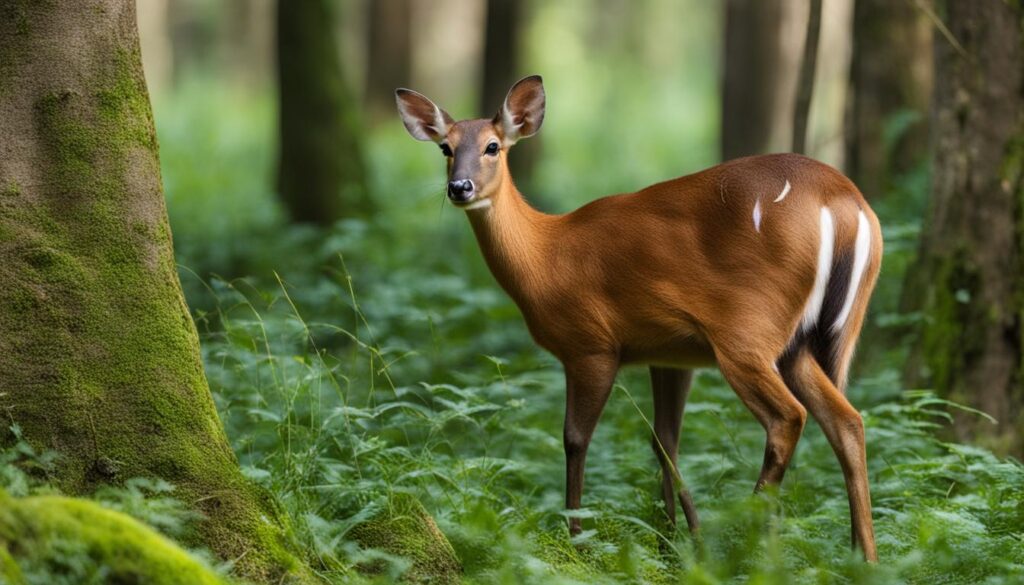
As the table demonstrates, muntjac deer have a diverse diet that allows them to take advantage of various food sources in their environment. This adaptability and eclectic feeding behavior contribute to their success in finding sustenance and surviving in different habitats.
The Origins and Spread of Muntjac Deer in the UK
Muntjac deer, also known as barking deer, are fascinating creatures that have made their way to the UK from the forests of Southeast Asia. These small deer species originate from countries such as China, Taiwan, and Indonesia. It is believed that they were introduced to the UK in the late 19th century, although the exact circumstances of their arrival in the wild remain unclear. Some speculate that they escaped from captivity, while others suggest that they were deliberately released.
Regardless of their origins, muntjac deer have successfully established themselves in the UK and have spread beyond their original range in southeast England. They can now be found throughout England and Wales, becoming a common sight in many areas. Their adaptability and ability to thrive in various habitats have contributed to their successful spread.
To give you a visual representation of the muntjac deer’s spread in England and Wales, here is a table showcasing the distribution of sightings in different regions:
| Region | Number of Sightings |
|---|---|
| South East England | 500 |
| South West England | 300 |
| East of England | 250 |
| West Midlands | 150 |
| North West England | 100 |
This table clearly demonstrates the widespread presence of muntjac deer across England and Wales. Their adaptability and ability to thrive in different regions have allowed them to colonize new areas and establish stable populations.
The introduction and spread of muntjac deer in the UK raise important questions about the impact of non-native species on native ecosystems. As an invasive species, muntjac deer can have ecological consequences, particularly in terms of their browsing habits and impact on woodland wildflowers. Conservation efforts are focused on managing their population and mitigating their impact on native flora and fauna.
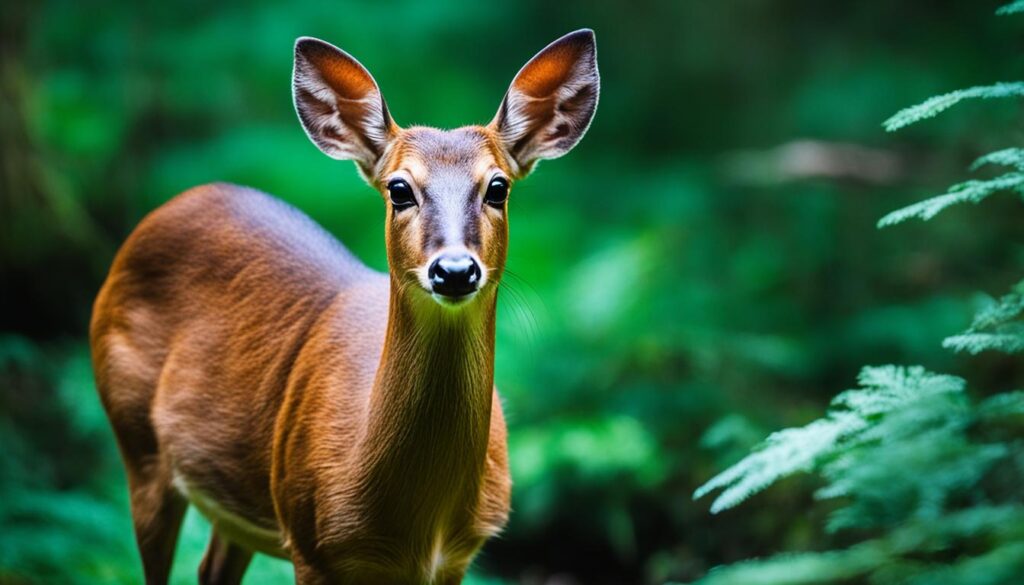
The Unique Teeth and Vocalizations of Muntjac Deer
Muntjac deer possess remarkable physical and auditory attributes that set them apart from other deer species. Their distinctive features include elongated canines, also known as “fangs” or “tusks,” as well as a diverse range of vocalizations.
Unlike their carnivorous counterparts, muntjac deer’s elongated canines are not used for hunting. Instead, these impressive teeth serve as a display of dominance during territorial disputes with other deer. Male muntjacs typically have longer and more prominent canines than their female counterparts.
Furthermore, muntjac deer are known for their vocal prowess. They produce various vocalizations, including grunting noises and a signature barking sound, earning them the moniker “barking deer.” Despite their small stature, these deer can be quite expressive and utilize vocalizations for multiple purposes, such as territorial communication, attracting mates, and warding off potential predators.
To experience the unique visual and auditory characteristics of muntjac deer, take a moment to observe these captivating creatures in the wild: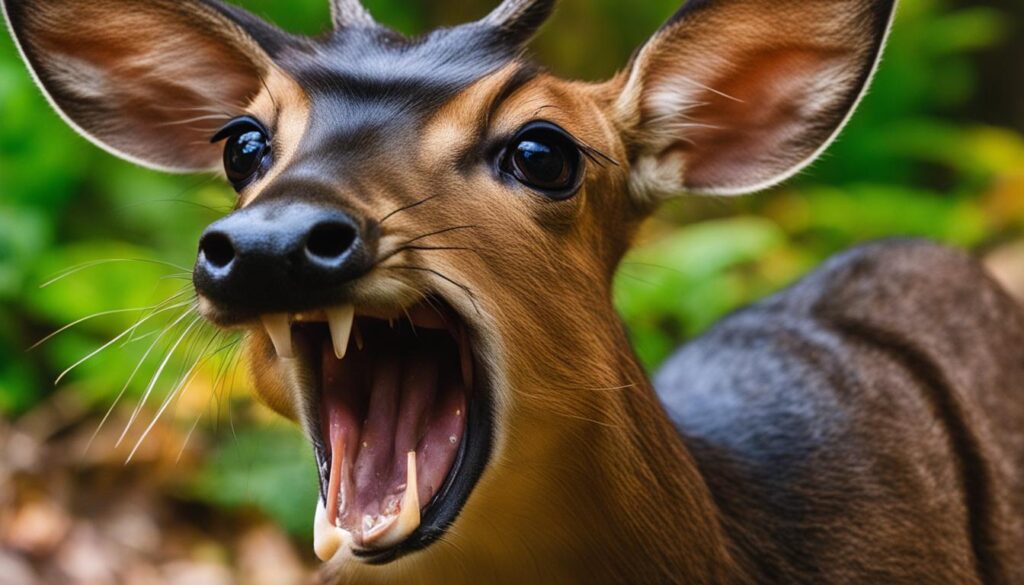
“The elongated canines of muntjac deer showcase their fascinating adaptations for intra-species interactions, while their vocalizations, especially the distinctive barking sound, provide a glimpse into their intricate communication strategies.” – Wildlife enthusiast
The Legal Status and Conservation of Muntjac Deer
In the UK, muntjac deer are classified as an invasive, non-native species as of 2019. It is illegal to release them into the wild, import them, breed them in captivity, or sell them. However, they are protected under the Deer Act 1991 and are not considered endangered.
Muntjac deer populations have been steadily increasing due to their adaptability and ability to thrive in various habitats. This has raised concerns among conservationists, as muntjacs can have a significant impact on native flora and fauna. They are known to browse on a wide range of plant species, including woodland wildflowers, which can disrupt local ecosystems.
Conservation efforts focus on managing the impact of muntjac deer on ecosystems and protecting native species from their browsing habits. This includes habitat management practices and research into alternative control methods. Additionally, public awareness campaigns educate the public about the legal status of muntjac deer and the importance of preventing their spread.
| Legal Status | Conservation Efforts |
|---|---|
| Classification: Invasive, non-native species | Managing impact on ecosystems |
| Illegal to release, import, breed, or sell | Protecting native species |
| Protected under the Deer Act 1991 | Habitat management practices |
Conservationists are working to strike a balance in the legal status of muntjac deer, recognizing their impact while ensuring their protection as part of the UK’s biodiversity. By implementing effective management strategies and promoting responsible actions, they aim to conserve native ecosystems and minimize the ecological disruption caused by this invasive species.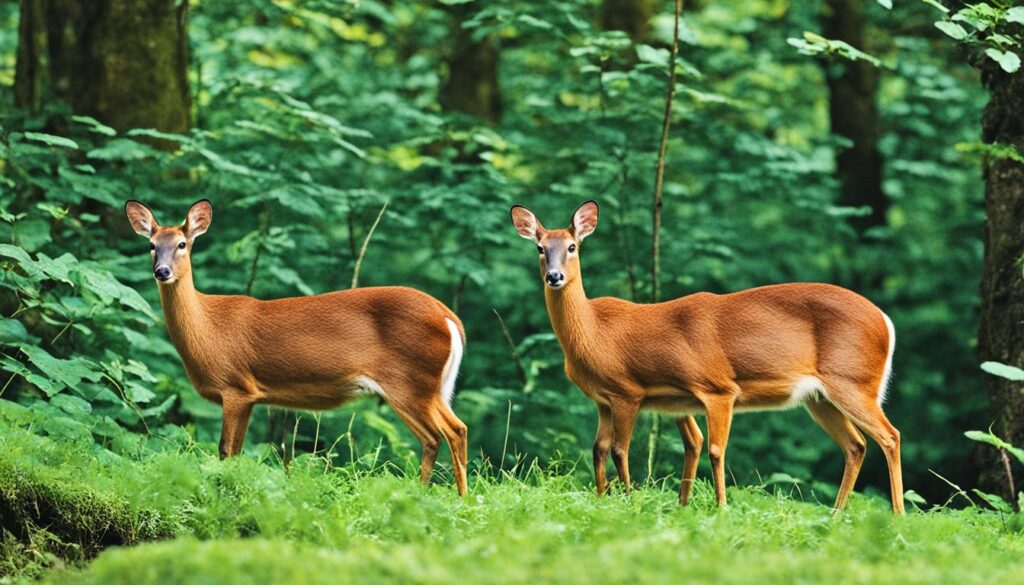
Conclusion
Muntjac deer are a fascinating and unique species that have captivated the attention of nature enthusiasts and researchers alike. With their small size, distinctive facial features, vocalizations, and adaptability, they have carved out a niche in the woodlands of England and Wales.
One of the most remarkable aspects of muntjac deer is their unique facial glands, which they use for communication and bonding with other deer. These glands, along with their reputation for their loud barking sound, set them apart from other deer species.
However, their adaptability and browsing habits have also had ecological impacts, particularly on woodland wildflowers. Despite being classified as an invasive species, muntjac deer are protected under UK law, highlighting the challenges of managing non-native species.
To mitigate their impact on ecosystems, conservation efforts focused on managing muntjac deer populations and protecting native species are crucial. Understanding the unique features, vocalizations, adaptability, and ecological impacts of muntjac deer is essential for effective conservation and sustainable management of these remarkable creatures.FAQ
What are the unique facial features of the Muntjac deer?
Why is the Muntjac deer known as the “barking deer”?
Where did the Muntjac deer originate from?
What impact do Muntjac deer have on ecosystems in the UK?
What is the diet of Muntjac deer?
Are Muntjac deer protected under UK law?
Paul’s love for animals knows no bounds. As a dedicated writer and animal lover, Paul brings a unique perspective to our team. His firsthand experiences with various animals enrich our content and provide valuable insights into their behavior and needs. Whether he’s sharing tips for pet care or shedding light on pressing conservation issues, Paul’s passion for animals shines through in everything he does.
Deers
Understanding Deer Poop: Tracking & Garden Health
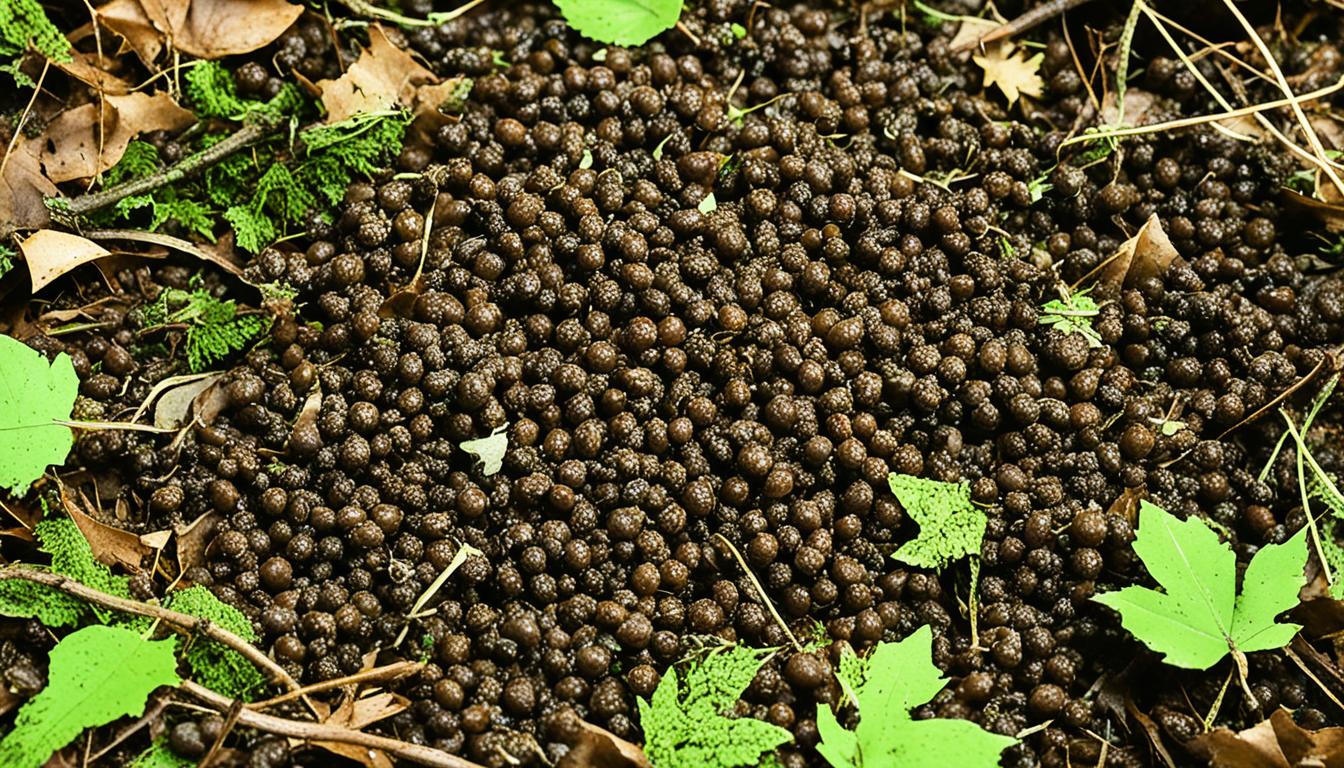
Did you know that deer poop can provide valuable insights into the behavior of deer? It can indicate where they are feeding, bedding, and traveling, making it an essential tool for both hunters and wildlife enthusiasts. Learning to identify deer scat correctly is crucial for tracking wildlife and assessing garden health. In this article, we will explore the main characteristics of deer poop, differentiate it from other animal droppings, and understand its significance in tracking deer and maintaining a thriving garden.
Key Takeaways:
- Deer poop can provide insights into deer behavior, such as feeding and traveling patterns.
- Identifying the main characteristics of deer scat is essential for tracking wildlife and assessing garden health.
- Deer poop can be differentiated from other animal droppings based on its appearance.
- It is not possible to determine the sex of a deer based on its droppings alone.
- Deer scat can be used as a natural fertilizer in gardens, but precautions should be taken.
Main Characteristics of Deer Poop
Deer poop has several main characteristics that can help identify it. It consists of brown, oval-shaped pellets that are typically between .2 to .5 inches in length. When fresh, deer scat has a shiny, wet appearance. Some pellets may be tapered on one end, while others may be perfectly round. The consistency of deer poop can range from moist to fibrous depending on the water content of their diet. There is typically no visible food in the pellets, giving them a uniform appearance. Moister scat may have clumps of pellets pressed together, while dryer scat will have a more scattered appearance.
Key Characteristics of Deer Poop:
- Brown, oval-shaped pellets
- Size between .2 to .5 inches
- Shiny, wet appearance when fresh
- Variation in shape, with some pellets tapered and others round
- Consistency ranging from moist to fibrous
- No visible food, uniform in appearance
- Moister scat may clump together, while dryer scat appears more scattered
Quote:
“Deer poop can provide valuable insights into the behavior of deer, making it essential to recognize its main characteristics.”
By understanding the main characteristics of deer poop, you can easily differentiate it from other animal droppings. This knowledge will enable hunters and wildlife enthusiasts to track deer movements accurately. Additionally, being able to identify deer poop can help gardeners assess deer activity on their property and take appropriate measures to protect their gardens.
Deer Poop Look-Alikes
When it comes to identifying deer poop, it’s essential to be able to differentiate it from other animal droppings. Here are some common look-alikes to be aware of:
Rabbit Scat
Rabbit scat is usually a pile of round, brown pellets. In comparison, deer pellets are more oval in shape.
Bear Scat
Bear scat is much larger and less-formed than deer scat. It often contains food remnants such as fruit pits, nut shells, or even human food or trash.
Elk Scat
Elk scat is similar in appearance to deer scat but larger in size. The size difference can help in accurately identifying deer scat.
Pronghorn Scat
Pronghorn scat may have a more irregular shape and can look like small chocolate chips.
By familiarizing yourself with the distinguishing characteristics of these look-alikes, you can confidently identify deer scat when you come across it.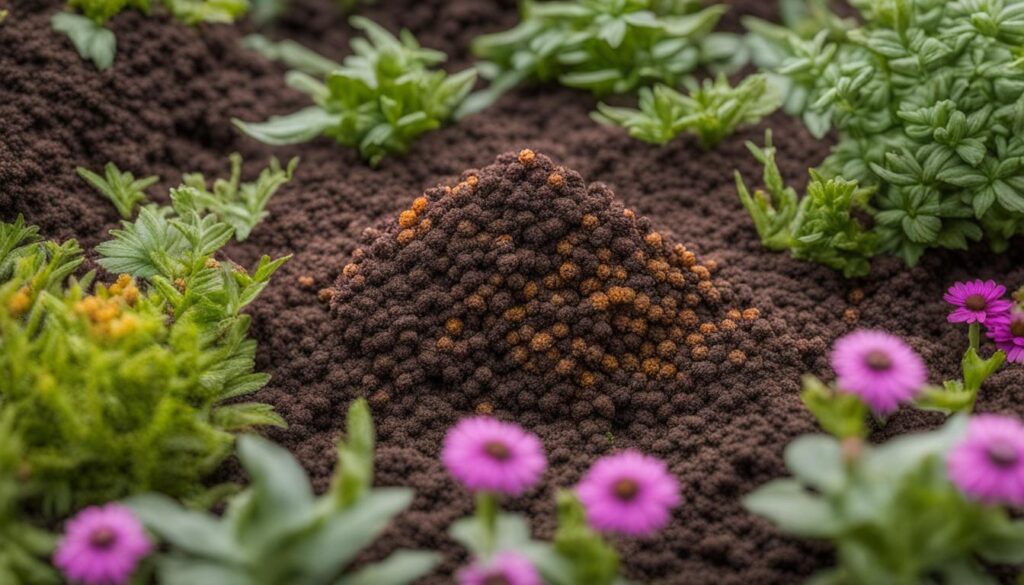
Buck vs. Doe Poop
Contrary to popular belief, it’s not possible to determine the sex of a deer based on their droppings alone. There is no discernible way to tell what produced a particular scat, whether it was a male or female deer. The size of the droppings can vary among individuals, with larger animals generally producing larger piles of pellets. Bucks may leave behind an average of 70 to 80 pellets, while does may leave an average of 50 to 60. However, these size differences cannot definitively indicate the sex of the deer.
Whitetail Poop vs. Mule Deer Poop
Whitetail poop and mule deer poop can be challenging to differentiate based solely on appearance. However, the primary distinction lies in their diet, heavily influenced by their respective regions. Whitetail deer inhabiting the eastern United States feed on a variety of lush, temperate-climate forbs and browse. On the other hand, mule deer in the Western and Southwestern regions have adapted to a diet dominated by shrubs.
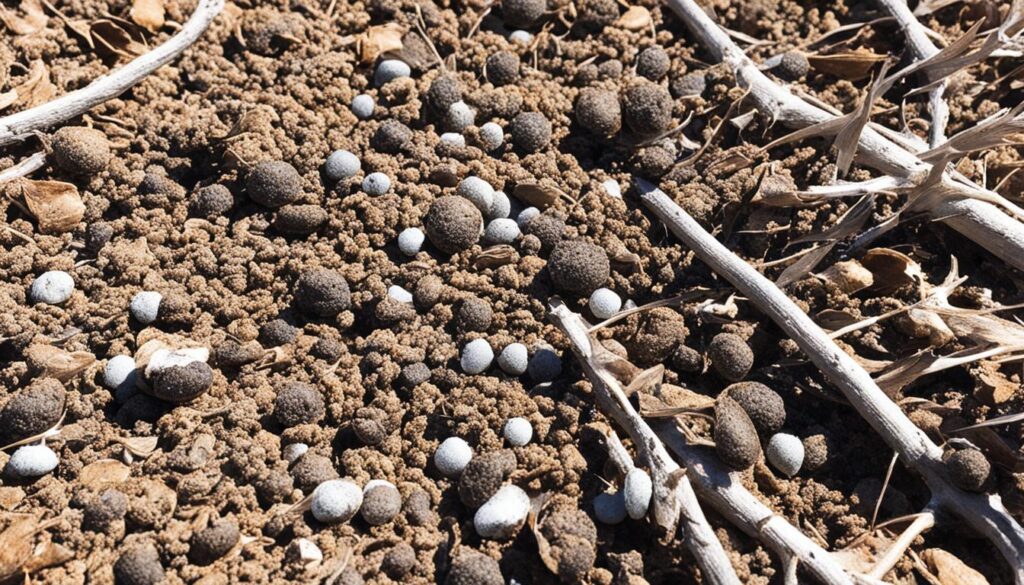
As a result of their dietary differences, mule deer scat tends to have lower moisture content and dries out more quickly in the arid climates of the West and Southwest. In regions where their ranges overlap, it becomes virtually impossible to differentiate between the scat of whitetail deer and mule deer.
The Importance of Deer Scat in Tracking and Gardening
Deer scat plays a vital role in tracking and understanding the behavior of deer. It holds valuable insights into their movements, feeding patterns, and favored resting places. Recognizing deer scat can be incredibly helpful for hunters, aiding them in identifying potential hunting spots and predicting deer movement. Additionally, deer scat serves as an essential indicator for gardeners, confirming the presence of deer on their property and allowing them to take necessary measures to protect their precious plants and flowers.
Moreover, deer scat is not only valuable to hunters and gardeners but also to scientists and researchers. It provides a wealth of information about herd health, hormone levels, and the presence of diseases like chronic wasting disease. Scientists study deer scat to understand the overall well-being of deer populations and make informed decisions for conservation efforts.
Understanding deer scat’s importance in tracking and gardening empowers individuals to make informed decisions in wildlife management and garden health. By learning to identify and analyze deer scat, enthusiasts can gain valuable insights into the lifestyle and habits of these majestic animals while simultaneously protecting their precious gardens.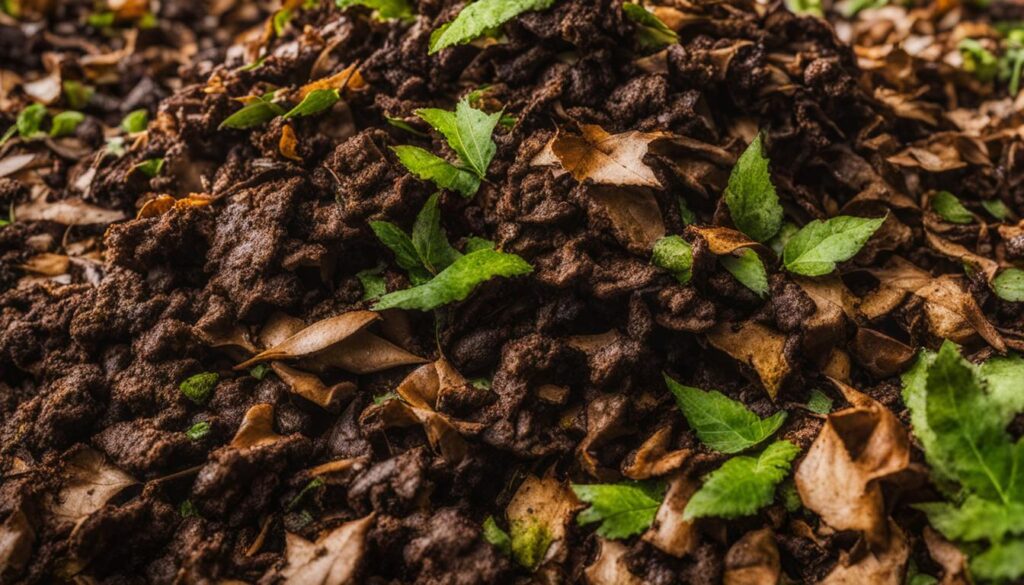
Deer Scat: A Closer Look
To fully appreciate the importance of deer scat, let’s take a closer look at its characteristics:
| Characteristics | Description |
|---|---|
| Shape | Oval-shaped pellets |
| Color | Dark brown |
| Size | Varies, but typically between .2 to .5 inches in length |
| Consistency | Moist to fibrous depending on the diet and water content |
By familiarizing yourself with these characteristics, you can easily distinguish deer scat from other animal droppings, ensuring accurate tracking and effective garden management.
Is Deer Poop Harmful?
Deer droppings are not typically harmful and are composed of plant matter that will break down over time. However, it’s important to exercise caution and avoid direct contact with deer droppings, especially if your yard is overrun with deer. While a few piles of deer droppings pose minimal risk to your backyard, pets, or gardens, it’s advisable to fence off your vegetable garden to avoid potential contamination. Always practice good hygiene when handling deer scat and wash your hands thoroughly afterwards.
Deer droppings, also known as deer scat, are a natural part of the environment and can be found in areas where deer frequently roam. They are typically small, dark-brown pellets that are easily recognizable. While deer poop is generally harmless, it’s important to take precautions to ensure garden safety and prevent any potential contamination. Here are some key points to consider:
Preventing Contamination
If deer frequently visit your garden, it’s a good idea to take measures to prevent contamination from their droppings. Fencing off your vegetable garden can help keep deer out and minimize the risk of them leaving droppings in the area where you grow your food. Additionally, practicing good hygiene when handling deer scat, such as wearing gloves and washing your hands thoroughly afterwards, can help reduce the risk of spreading any potential contaminants.
Garden Safety
Deer droppings are primarily composed of plant matter and will break down over time. However, if you have a large amount of deer poop in your garden, it can affect the overall health and safety of your plants. Deer poop contains high levels of nitrogen, which can be beneficial for plant growth when properly composted. However, if not properly managed, an excessive amount of deer droppings can lead to an imbalance in the nutrient levels and potentially harm your plants. It’s important to monitor the amount of deer scat in your garden and take appropriate action to maintain a healthy balance.
By taking precautions to prevent contamination and ensuring a balanced amount of deer poop in your garden, you can enjoy the presence of deer while promoting garden safety and maintaining a thriving garden.
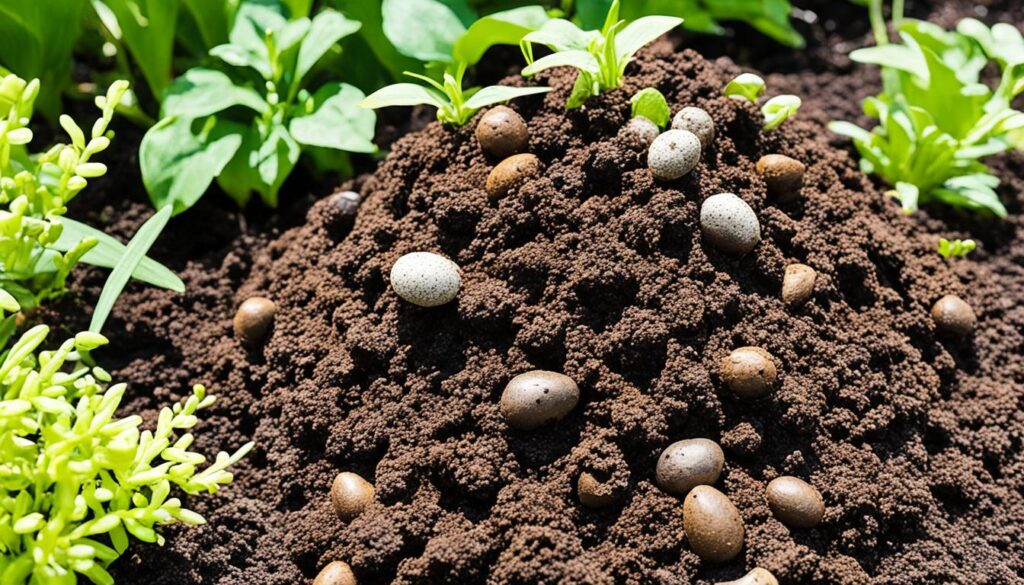
| Animal | Appearance | Size | Composition |
|---|---|---|---|
| Deer | Small, dark-brown pellets | 0.2-0.5 inches in length | Primarily plant matter |
| Rabbit | Round, brown pellets | Varies | Primarily plant matter |
| Bear | Larger, less-formed | Varies | May contain food remnants |
| Elk | Similar to deer scat | Larger than deer scat | Primarily plant matter |
Where Do Deer Usually Poop?
Deer tend to have specific areas where they prefer to relieve themselves, which can provide valuable insights into their habits and whereabouts. Understanding their pooping habits can help you track their movements and optimize your hunting or gardening strategies accordingly.
- Bedding Areas: Deer typically defecate shortly after waking up, near their bedding areas. These areas are where deer rest and seek shelter, such as thickets, tall grasses, or wooded areas.
- Feeding Areas: You can often find piles of deer poop near their feeding areas. Deer are herbivores and feed on various vegetation, so look for their droppings in areas with abundant food sources like fields, meadows, or the edges of forests.
- Daily Roaming: Since deer poop throughout the day, you may come across their droppings almost anywhere they roam. They tend to leave their droppings as they move around their habitat, so keep an eye out for deer poop along trails, near water sources, or even in your own backyard if they frequent the area.
By identifying the locations where deer poop is concentrated, you can gain insights into their daily routines and preferred areas. This knowledge can be invaluable for hunters looking to track deer or for gardeners seeking to understand deer behavior and protect their gardens from deer browsing.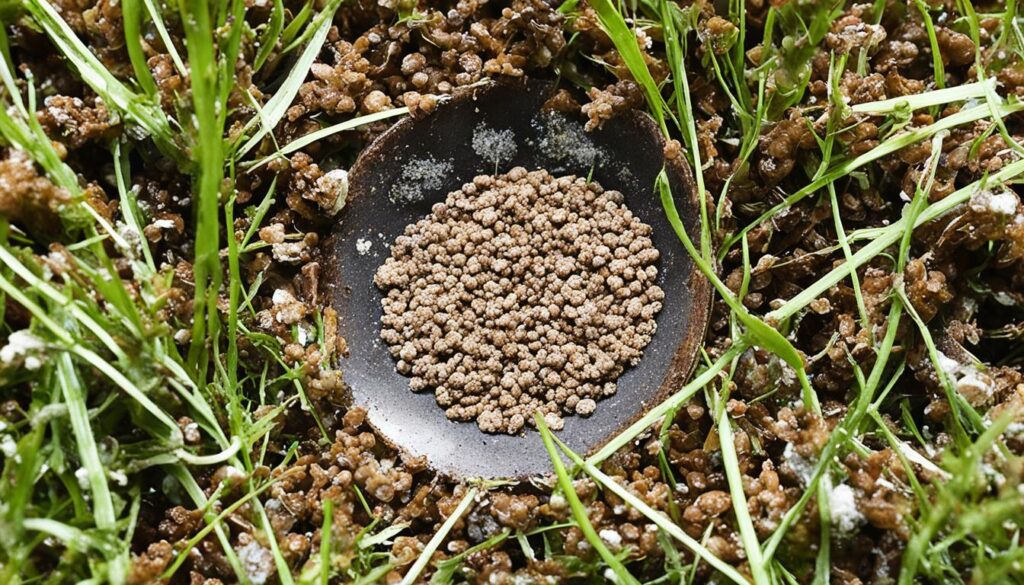
Note: Image above depicts deer poop, providing a visual reference for the topic of this section.
Can I Use Deer Poop in My Garden?
Yes, you can use small amounts of deer poop as a natural fertilizer in your garden. Deer droppings contain a high amount of nitrogen, which is a vital nutrient for plant growth. Nitrogen helps plants produce lush, green foliage and promotes healthy development.
However, before using deer poop as fertilizer, it’s crucial to ensure that the manure has aged properly to avoid potential bacterial contamination. Fresh deer scat may contain harmful pathogens that can pose a risk to human health. It’s recommended to allow the manure to decompose for at least 90 to 120 days before using it in your garden.
The aging process allows any bacteria present in the manure to break down, making it safe for use as a fertilizer. Once properly aged, deer poop can be an excellent eco-friendly option to enhance the health and productivity of your garden.
When applying deer poop, it’s best to spread it evenly over the soil surface and then water it in. The nutrients from the manure will slowly release into the soil, providing a steady supply of nutrition to your plants. Remember to avoid over-fertilizing, as excessive nitrogen content can harm plants.
Benefits of Using Deer Poop as Fertilizer:
- Rich in nitrogen: Deer droppings are packed with nitrogen, a crucial nutrient for plant growth.
- Slow-release: Deer poop releases nutrients gradually, providing a steady supply for your plants.
- Eco-friendly: Using deer poop as fertilizer is a natural and sustainable way to enhance garden health.
- Cost-effective: Instead of purchasing commercial fertilizers, deer poop can be a free and readily available option.
By incorporating deer poop into your garden routine, you can improve soil fertility, promote healthy plant growth, and reduce the need for synthetic fertilizers.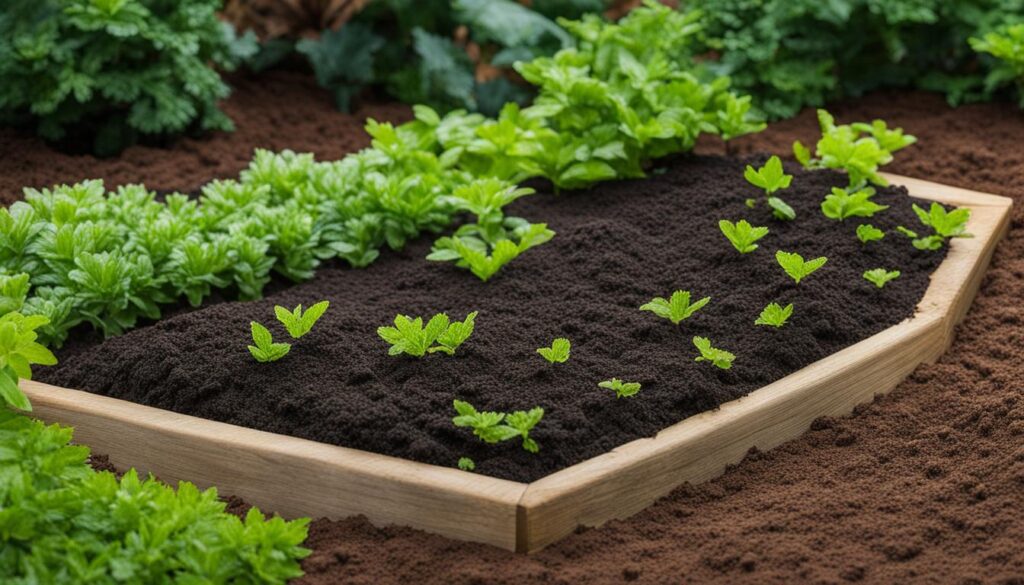
Remember to always practice proper hygiene when handling deer droppings or any other type of organic fertilizer. After handling the manure, wash your hands thoroughly to prevent the spread of bacteria.
Conclusion
Deer poop, also known as deer scat, offers valuable insights into the behavior of these majestic creatures. By understanding the main characteristics of deer poop and being able to differentiate it from other animal droppings, hunters and wildlife enthusiasts can track the movements and patterns of deer. Whether it’s determining where deer feed, bed down, or travel, the presence of deer scat provides important clues.
Moreover, deer scat plays a significant role in assessing the health of your garden. The presence of deer poop can confirm the presence of deer on your property, allowing you to take necessary measures to safeguard your garden. Additionally, scientists rely on deer scat to study herd health, hormone levels, and the presence of diseases like chronic wasting disease.
Understanding the significance of deer poop in tracking wildlife and assessing garden health is essential. By honing your identification skills and recognizing the distinguishing characteristics of deer scat, you can gain a deeper appreciation and knowledge of these magnificent creatures. So, the next time you come across deer poop, remember the valuable insights it offers into the world of deer and the role it plays in tracking wildlife and promoting garden health.FAQ
What are the main characteristics of deer poop?
How can I differentiate deer poop from other animal droppings?
Can deer poop indicate the sex of the deer?
How can I differentiate between whitetail poop and mule deer poop?
What is the importance of deer scat in tracking and gardening?
Is deer poop harmful?
Where do deer usually poop?
Can I use deer poop as fertilizer in my garden?
Paul’s love for animals knows no bounds. As a dedicated writer and animal lover, Paul brings a unique perspective to our team. His firsthand experiences with various animals enrich our content and provide valuable insights into their behavior and needs. Whether he’s sharing tips for pet care or shedding light on pressing conservation issues, Paul’s passion for animals shines through in everything he does.
Deers
Best Shot Placement for Deer Hunting Success
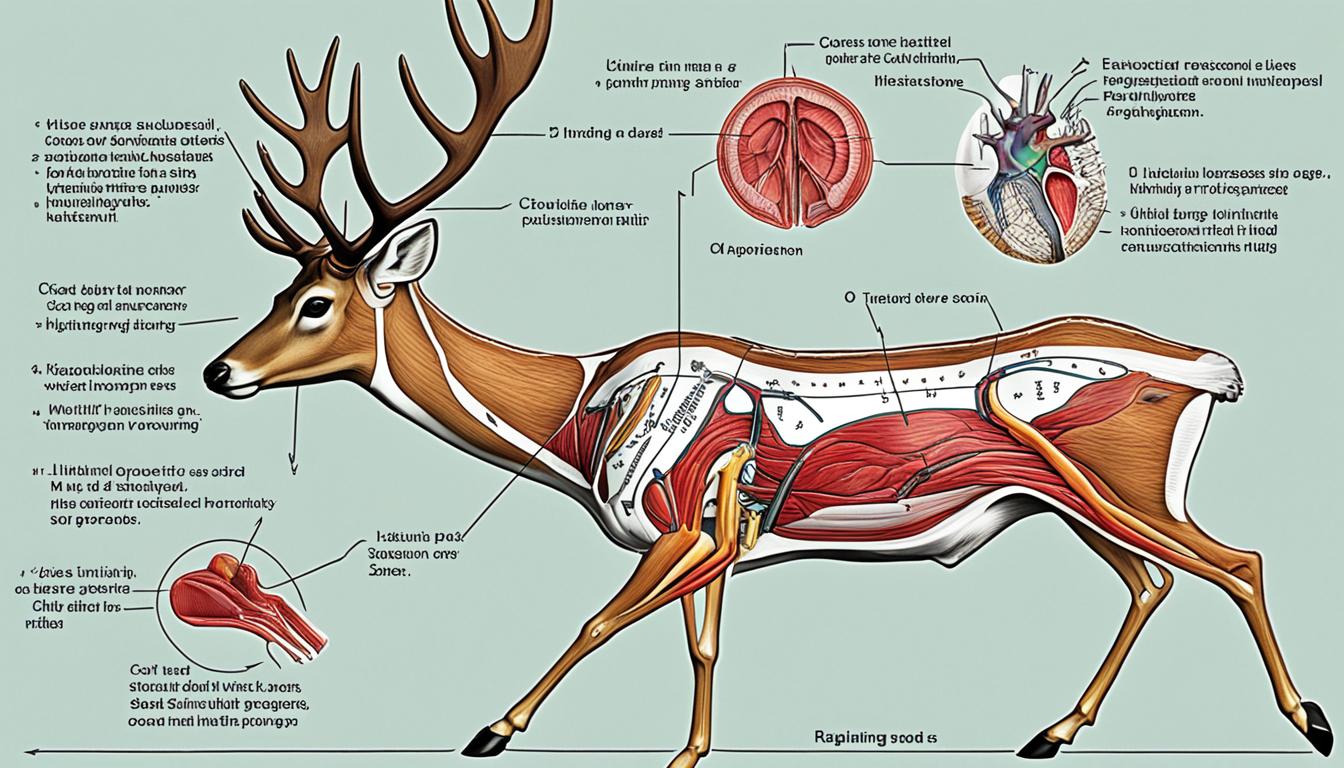
Every hunter knows that shot placement is crucial for a successful and ethical deer harvest. Understanding deer anatomy and knowing where to aim from different angles can significantly increase your chances of making a clean, ethical kill. Did you know that more than 50% of hunters wound and do not recover their deer due to poor shot placement? This startling statistic highlights the importance of mastering shot placement techniques to ensure a humane and responsible hunt. In this comprehensive guide, we will delve into the vital organs of a deer, the best shot placements for various angles, and the importance of precision in hunting.
Key Takeaways:
- Shot placement is essential for a successful and ethical deer harvest.
- Poor shot placement can result in wounding and lost deer.
- Understanding deer anatomy is crucial for accurate shot placement.
- The heart and lungs are the primary targets for a swift and clean kill.
- Mastering shot placement techniques ensures a responsible and humane hunt.
Deer Anatomy 101
To improve shot placement, it’s essential to have a good understanding of deer anatomy. The vital organs, such as the heart, lungs, and liver, are prime targets for ethical kills. The lungs, located behind the front shoulder, offer a larger target with a higher margin of error. The heart, partially covered by the lungs, is a smaller but equally important target. The liver, hidden behind the diaphragm, is smaller and more challenging to hit. By knowing the location of these vital organs and understanding the deer’s physical structure, you can make more accurate shots from any angle.
| Vital Organs | Location | Shot Difficulty |
|---|---|---|
| Lungs | Behind the front shoulder | Relatively easier |
| Heart | Partially covered by the lungs | Requires precision |
| Liver | Behind the diaphragm | More challenging |
Deer Vital Organs: Heart and Lungs
When it comes to deer hunting, targeting the heart and lungs is crucial for a quick and humane kill. A well-placed shot to the lungs results in rapid blood loss and organ failure, ensuring a swift and clean takedown. This shot placement technique is highly effective and forgiving, making it an excellent choice for less experienced hunters seeking a quick kill.
Another vital organ to target is the heart. While hitting the heart requires more precision and skill due to its smaller size and the potential movement of the deer, it can result in an equally swift and ethical kill. A heart shot also leads to rapid blood loss and organ failure, incapacitating the deer swiftly.
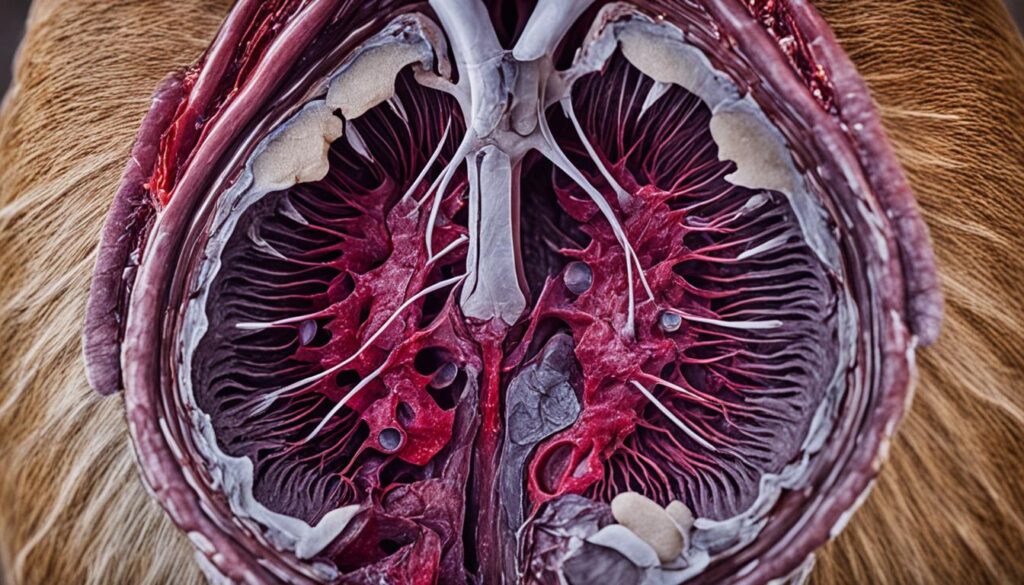
Both the lung shot and heart shot are reliable choices for ethical hunting, but they require different levels of accuracy. The lung shot provides a larger target area and allows for a higher margin of error, making it an ideal option for hunters who may not have mastered extreme precision. On the other hand, the heart shot demands more skill and control due to its smaller size and the need to compensate for potential deer movement.
Choosing between a lung shot and a heart shot depends on a hunter’s skill level and the specific circumstances of the shot. It’s essential to consider factors such as the distance, angle, and the deer’s behavior before deciding which target to aim for. Regardless of the chosen shot, hitting either the heart or lungs will result in a quick and ethical kill, minimizing suffering for the animal.
Tissue, Muscle, and Bones in the Deer’s Body
Deer possess a formidable defense system composed of muscles, bones, and tissue that serve to protect their vital organs. Understanding the anatomy of these organs and the tough structures surrounding them is essential for achieving successful shot placement during hunting.
Protective Shoulders and Scapula
The shoulder and scapula play a crucial role in providing power for a deer’s movement. However, their positioning also makes them challenging targets. Achieving precise shot placement in this area demands skill and accuracy to avoid wounding the animal instead of making a clean kill.
The High-Stakes Shot: The Spine
The spine presents hunters with a high-risk, high-reward shot opportunity. A well-placed shot targeting the spine offers an instant takedown, rendering the deer immobile. However, due to the small target area and the potential for erratic movement, tremendous accuracy is required to make this shot a success.
Targeting the Rib Cage: The Kill Zone
The rib cage, encompassing the heart and lungs, is considered the optimal kill zone. Understanding the position of the rib cage provides hunters with a clear target area for achieving a clean kill. Precise shot placement within this region ensures swift organ damage, leading to a quick and ethical takedown with minimal suffering.
| Target Area | Importance |
|---|---|
| Rib Cage | The sweet spot for a clean kill, housing the vital heart and lungs. |
| Shoulder and Scapula | Challenging targets that require precision shooting skills. |
| Spine | A high-stakes shot offering an instant takedown but demanding unparalleled accuracy. |
Understanding the structural barriers protecting the vital organs is essential for successful shot placement during deer hunting. By being knowledgeable about the shoulder and scapula, spine, rib cage, and the corresponding kill zones, hunters can enhance their accuracy and increase the probability of a swift and ethical kill.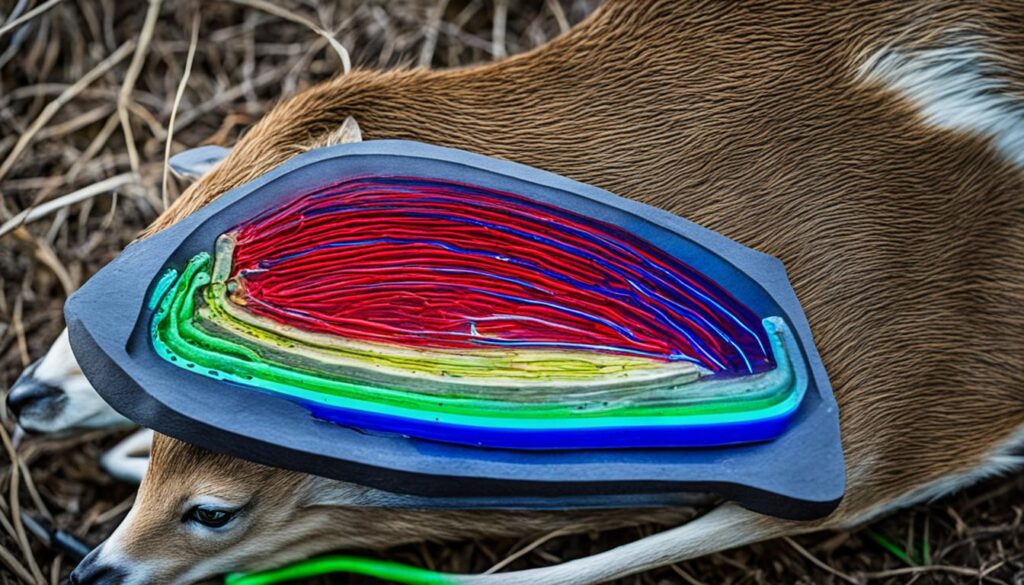
What’s the Best Shot Placement on Deer?
The best shot placement on a deer is targeting the lungs. Due to their larger size and proximity to the heart, the lungs offer the most substantial kill zone and safety net. A clean shot to this area causes rapid blood loss and organ failure, resulting in a quick and efficient kill. While hitting the heart and lungs is a deadly combination, it requires more precision. The lungs remain the optimal target for a clean and ethical takedown.
When hunting deer, understanding the best shot placement is vital for achieving a quick and ethical kill. By focusing on the lungs, hunters can increase their chances of success while minimizing unnecessary suffering for the animal.
“Targeting the lungs provides a larger margin of error and ensures a humane, ethical kill,” says seasoned hunter and wildlife expert, John Anderson. “Hitting this vital organ leads to rapid blood loss and subsequent organ failure, resulting in a clean and effective takedown.”
While the heart and lungs present a deadly combination, it’s important to note that hitting the heart requires more precision due to its smaller size and potential movement of the deer. The lungs, on the other hand, offer a larger target area, increasing the chances of a successful shot. For hunters, the lungs remain the optimal kill zone.
To illustrate the effectiveness of targeting the lungs, let’s take a closer look at the anatomy of a deer: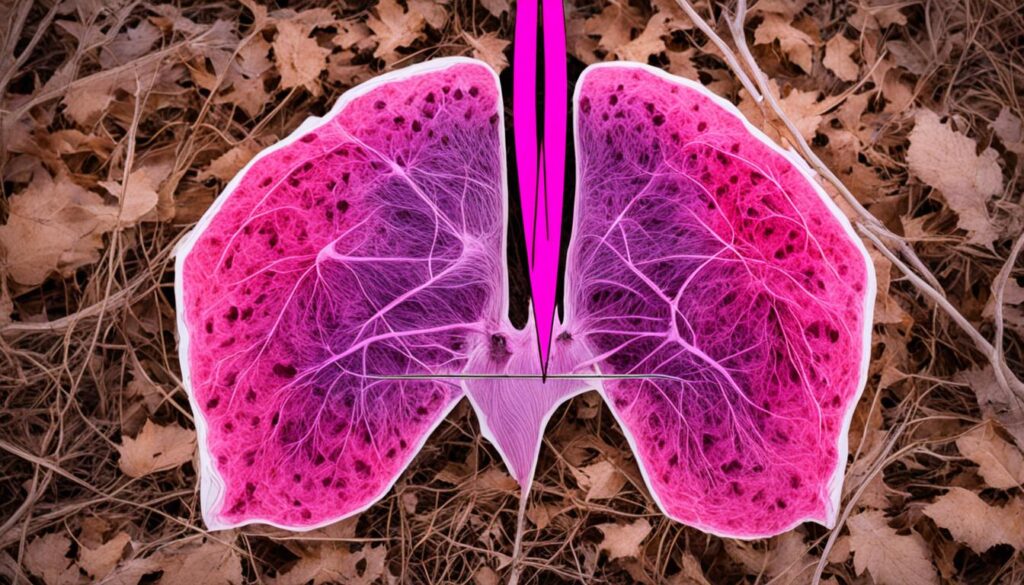
| Vital Organs | Location | Target Characteristics |
|---|---|---|
| Lungs | Behind the front shoulder | – Larger target – Higher margin of error |
| Heart | Partially covered by the lungs | – Smaller target – Higher precision required |
| Liver | Hidden behind the diaphragm | – Smaller target – More challenging to hit |
As shown in the table above, the lungs are easily accessible behind the front shoulder, providing a larger target area and a higher margin of error. This makes them the ideal kill zone for ethical hunters.
By focusing on effectively targeting the lungs, hunters can achieve quick and clean kills, ensuring a more responsible approach to hunting and conservation.
Deer Shot Placement Guide Based on Hunter Angles
The angle and distance between the hunter and the deer play a critical role in shot placement. Understanding the different angles and their implications can help hunters make informed decisions for successful and ethical kills.
Broadside Shot
The broadside shot occurs when the deer is perpendicular to the hunter. This angle provides the best opportunity to hit the vital organs, including the heart and lungs, with a broad target area. It offers a high chance of quick and effective kills.
Quartering-Away Shot
The quartering-away shot is when the deer’s body is angled away from the hunter. While not as ideal as the broadside shot, it still allows access to the heart and lungs. Hunters must aim behind the shoulder, towards the midsection of the deer, to achieve optimum shot placement and a clean kill.
“The broadside shot provides the best opportunity to hit the vital organs, while the quartering-away shot can still offer a good chance for an ethical kill.”
Quartering-Towards Shot
The quartering-towards shot presents a more challenging scenario. This angle carries a higher risk of hitting the front shoulder and guts instead of the vital organs. It is not recommended unless the hunter is experienced and confident in their accuracy. In such cases, one must aim towards the front part of the deer, just behind the shoulder, to avoid hitting non-vital areas.
To summarize, understanding the broadside, quartering-away, and quartering-towards shots is crucial for hunters to make accurate and ethical shot placements. The broadside shot offers the best opportunity to hit the vital organs, while caution must be exercised with the quartering-away and quartering-towards shots to avoid potential damage to non-vital areas.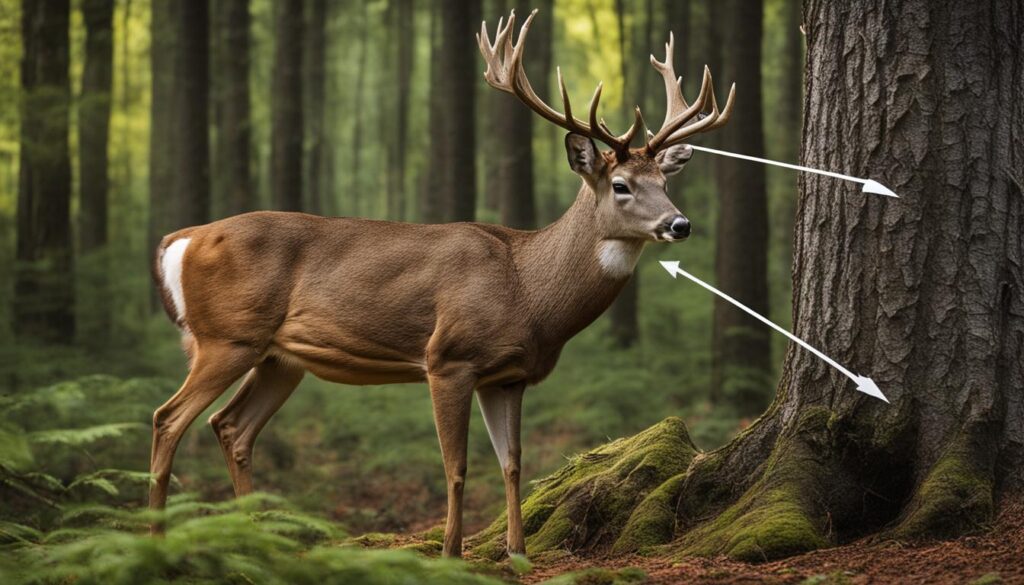
| Shot Angle | Advantages | Considerations |
|---|---|---|
| Broadside Shot | Perpendicular position offers a broad target area to hit vital organs. | Optimal shot placement with higher chances of quick and humane kills. |
| Quartering-Away Shot | Access to the heart and lungs, allowing for an ethical kill. | Requires aiming behind the shoulder to hit vital organs accurately. |
| Quartering-Towards Shot | Challenging angle that requires precision and experience. | Higher risk of hitting non-vital areas such as the shoulder and guts. |
Other Shot Placements and Considerations
While the broadside and quartering-away shots are the preferred choices, it’s important for hunters to be aware of other shot placements and the associated considerations. These alternative shots may come with higher risks or may not be recommended for various reasons. Let’s take a closer look at each one:
Frontal Shot
The frontal shot involves targeting the deer head-on. However, this shot presents a small target, making it challenging to hit the vital organs accurately. It also carries the potential risk of obstructing bone and fatty tissue, further reducing the chance of an effective kill. Due to the difficulty and the potential for wounding rather than killing the deer, the frontal shot is generally not recommended.
Head/Neck Shot
The head/neck shot involves aiming at the deer’s head or neck region. While it may seem like a precise shot, it comes with significant risks. A misplaced head/neck shot can result in poor shot placement, causing unnecessary suffering for the animal and potential damage to the meat. This shot is not advisable for ethical and effective deer hunting.
Straightaway Shot
The straightaway shot occurs when the deer is moving directly away from the hunter. While it may seem like an open opportunity for a shot, it can lead to poor shot placement and reduced chances of a clean kill. In addition, hitting the deer in the hindquarters may result in minimal damage and the risk of a wounded animal. Therefore, the straightaway shot is not the preferred choice for ethical hunting.
Straight-Down Shot
The straight-down shot is only available when hunting from treestands. It involves aiming at a deer directly below the hunter. This shot presents a small and challenging target, requiring exceptional accuracy. While it may seem tempting, the straight-down shot should be approached with caution. Misplaced shots can result in wounded animals and unnecessary suffering. Consider the difficulty and the potential risks carefully before attempting a straight-down shot.
Understanding these considerations and the associated risks can help hunters make ethical decisions in the field. By prioritizing precise shot placement and choosing the optimal angles, hunters can contribute to the successful and responsible harvest of deer.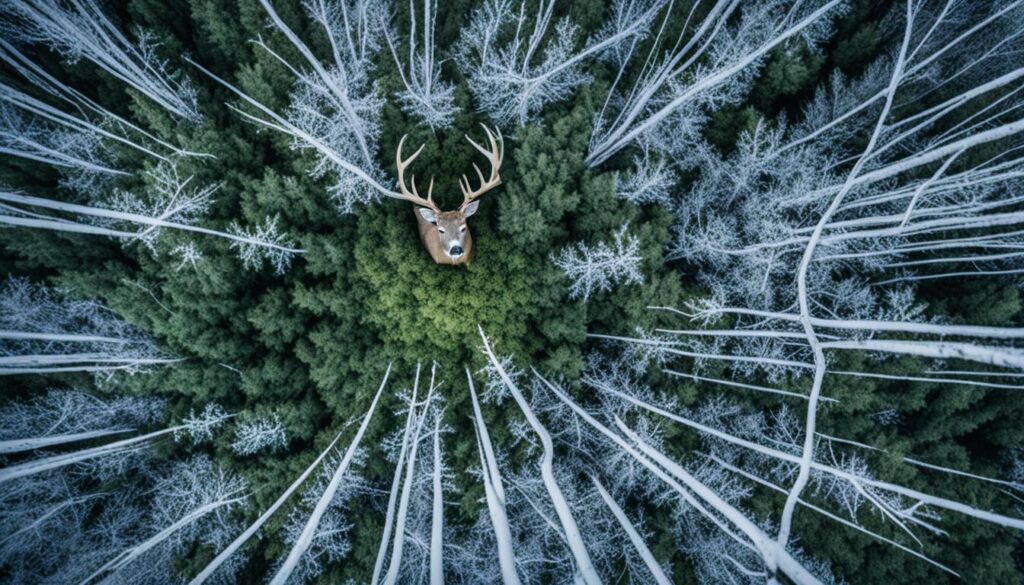
Deer Shot Placement Tips and Factors to Consider
When preparing to take a shot at a deer, it’s important to consider various factors that can affect shot placement. One vital factor is the deer’s head position. A deer with its head down is more likely to react quickly and drop lower to the ground upon hearing the shot. This natural reaction can significantly impact the trajectory of your shot, potentially resulting in a missed or ineffective shot. It’s crucial for hunters to be aware of the deer’s head position and adjust their aim accordingly to compensate for any movement.
In addition to head position, another factor that hunters must account for is the potential for string jump. String jump occurs when a deer reacts to the sound of a shot by instinctively dropping its body to avoid the perceived threat. This reaction can cause the shot to impact higher on the deer’s body than intended, potentially resulting in a non-lethal or non-ideal shot. To compensate for string jump, hunters should aim slightly lower than the desired target, taking into consideration the deer’s reaction time.
Understanding these natural reactions and compensating for movement is essential in achieving precise shot placement. By carefully observing the deer’s head position and anticipating the potential for string jump, hunters can make the necessary adjustments to ensure a clean and ethical kill. A successful shot not only requires technical skill and accuracy but also a deep understanding of the animal’s behavior and natural instincts.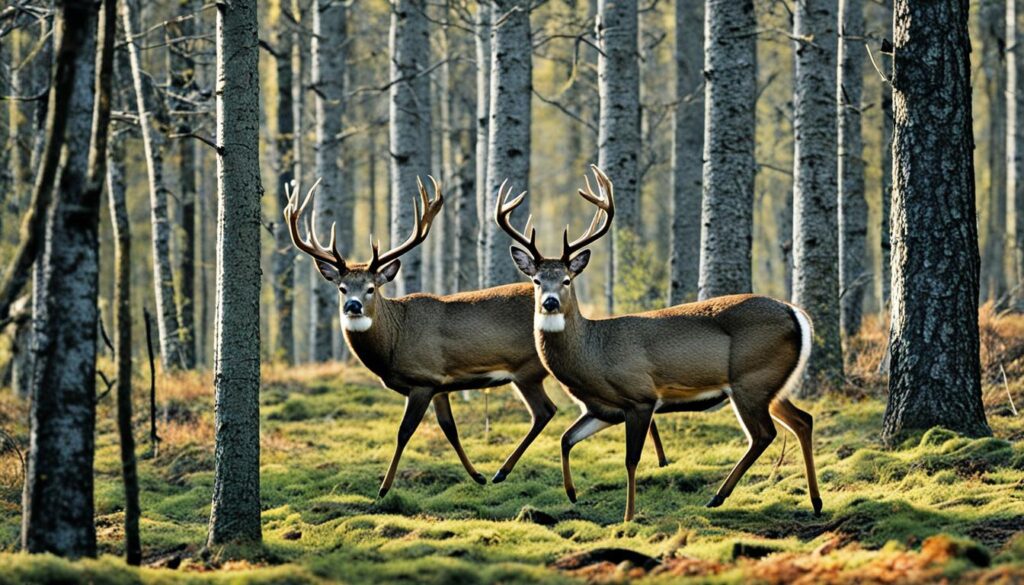
Remember, each hunting situation is unique, and it’s essential to assess the circumstances carefully. Taking the time to evaluate the deer’s head position, anticipate any potential reactions, and compensating for movement can significantly improve shot placement and increase the chances of a clean and ethical kill. By prioritizing precision and adapting to the deer’s behavior, hunters can contribute to responsible hunting practices and ensure humane harvests.
Conclusion
Mastering precise shot placement is the cornerstone of ethical hunting and ensuring a clean and humane kill. By understanding the anatomy of a deer and the vital organs involved, hunters can significantly increase their chances of success in the field while minimizing unnecessary suffering for the animal.
When aiming for a clean kill, hunters should prioritize targeting the heart and lungs. These vital organs provide the largest kill zone and offer a higher margin of error. By aiming for this area, hunters can achieve a quick and efficient takedown, leading to a clean harvest.
Remember, ethical hunting means making every shot count. By practicing precise shot placement and prioritizing clean kills, hunters can contribute to the responsible and sustainable management of deer populations. Let us embrace the importance of precision and ethical hunting practices for a more responsible future in the field.FAQ
What is the best shot placement for deer hunting success?
What should I know about deer anatomy?
Where should I aim for a quick and clean kill?
Are there any challenging shot placements on a deer?
What are the preferred angles for shot placement?
Are there any shot placements that are not recommended?
What factors should I consider for shot placement?
How important is precise shot placement in hunting?
Paul’s love for animals knows no bounds. As a dedicated writer and animal lover, Paul brings a unique perspective to our team. His firsthand experiences with various animals enrich our content and provide valuable insights into their behavior and needs. Whether he’s sharing tips for pet care or shedding light on pressing conservation issues, Paul’s passion for animals shines through in everything he does.
-

 Vetted2 months ago
Vetted2 months ago15 Best Cat Foods for Managing Hyperthyroidism – Vet Approved and Feline Friendly
-
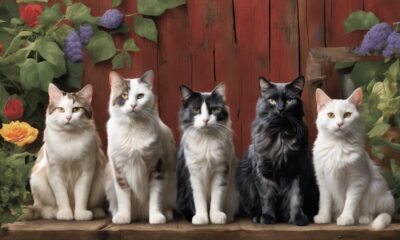
 Cats7 months ago
Cats7 months agoTop 5 Cat Breeders in Arkansas: A Guide
-
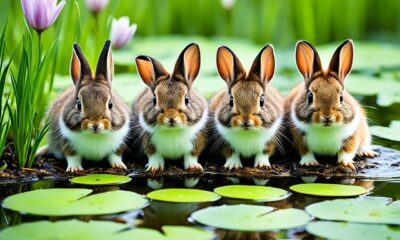
 Animal Facts2 months ago
Animal Facts2 months agoSpring Animals: A Guide to Seasonal Wildlife
-

 Vetted2 months ago
Vetted2 months ago15 Best Fresh Dog Food Delivery Services for Your Pup's Health and Happiness
-
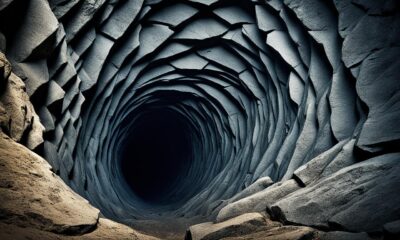
 Rabbits2 months ago
Rabbits2 months agoExploring Rabbit Holes: What Do They Look Like?
-
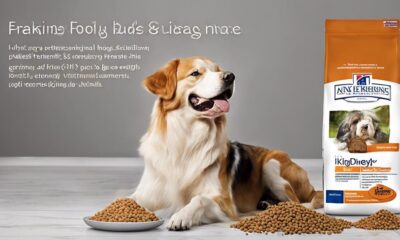
 Vetted1 month ago
Vetted1 month ago15 Best Dog Foods for Kidney Disease – Expert Recommendations for Your Pet's Health
-
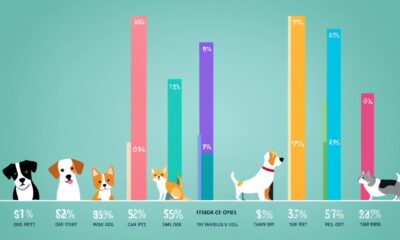
 Pets2 months ago
Pets2 months agoLatest Pet Statistics in US – Trends & Insights in 2024
-
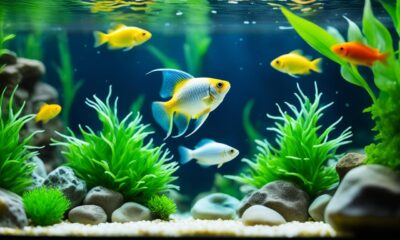
 Fish2 months ago
Fish2 months agoKeeping Your Sucker Fish Thriving at Home




